‘I’d

Don’t get a hearing aid until you’ve read this

‘I’d

Don’t get a hearing aid until you’ve read this


Whether you already wear a hearing aid or not – the choice of models has never been more extensive than right now. But which one is right for YOU? is new 20 page FREE colour guide will open your eyes to just what is available. Inside, you’ll nd everything you need to know explained in clear, easy to understand English.
Your questions answered including...

When’s the right time to seek hearing loss help?
How well can my hearing be improved?
How many di erent hearing aids are there?
Where can I try one of the new invisible aids?
Who has the best ‘speech-in-noise’ aids –so I can enjoy conversation at parties?
Can I have an ‘instant- t- and-go’ aid?
Which aids give the most natural experience?
How di cult is it to qualify for an NHS aid
and what are the wait times?
What are the limitations of NHS aids?







How good are the latest private hearing aids?
How do I get a Free Home Trial?
Do I have the right to choose between an NHS or Private hearing aid?





we love Pe R sonal naRR atives here at Reader’s Digest , and they don’t come any more heartwarming than Lynne Wallis’ memories of her jazz-loving father, and how he inspired her to pursue a second career. Anyone with similar dreams should turn to p50.
Elsewhere, Chris Jones’ poetic account of his trip to Antarctica on p94 might put British temperatures into perspective, while Tim Bouquet’s gritty feature on p80 about migrants fleeing Africa for Europe shines a much-needed light on a controversial issue. And if you’re in need of a bit of Hollywood glamour, we mark The Sound of Music’s 50th birthday on p22 by chatting with Charmian Carr, who played the eldest von Trapp daughter in the classic film.
But the most crucial subject this month is, of course, pies. Conscious that we don’t discuss this delightful food anything like enough, we pick out the best pastry-encrusted delights on p58. Bon appétit!

Tom browne
theeditor@readersdigest.co.uk
facebook.com/readersdigestuk
twitter.com/readersdigestuk
pinterest.com/rdigestuk
google.com/+ReadersDigestuK1










Editor-in-ChiEf Tom Browne
Sub-Editor Laura Dean-Osgood
digital ContEnt Editor Mandi Goodier
art dirECtor Yvey Bailey
graphiC dESignEr Katie Johnson
advErtiSing dirECtor Simon Fulton simon.fulton@readersdigest.co.uk
0203 701 5936
advErtiSing aCCount dirECtor Mike Allen mike.allen@readersdigest.co.uk
0203 701 5935
CEo Gary Hopkins
opErationS dirECtor Julie Leach
digital MarkEting and CaMpaignS
ManagEr Maggie Champion
digital ContEnt ExECutivE Kylie Petitt
thE rEadEr’S digESt aSSoCiation inC (uSa) president and Chief Executive officer
Bonnie Kintzer
vice president, Chief operating officer, international Brian Kennedy
Editor-in-Chief, international Magazines Raimo Moysa
W E pay...
£50 for the star letter and £30 for regular letters.
Email readersletters@readers digest.co.uk or go to readers digest.co.uk/contact-us
W E al S o pay...
£50 for the true stories, anecdotes, jokes in laugh! and you Couldn’t Make it up…, and contributions to end-ofarticle fillers and My great Escape.
Email excerpts@readersdigest.co.uk or go to readersdigest.co.uk/contact-us
We cannot acknowledge or return unpublished items or unsolicited article-length manuscripts. Do not send SAEs. Article-length stories, poetry and cartoons are not requested.
Contact Customer Services for renewals, gifts, address changes, payments, account information and all other enquiries. Call 0330 333 2220* or email customer_service@readersdigest.co.uk
talking M aga Z in E S
Reader’s Digest is available in a talking edition for blind and partially sighted people for £16. For details, call 01435 866 102, email info@tnauk.org.uk or visit tnauk.org.uk
Visit readersdigest.co.uk or write to: Reader’s Digest, PO Box 7853, Ringwood BH24 9FH. uk: £45.48 a year. republic of ireland: €61.20 a year. Prices include delivery. For gift subscriptions, contact Customer Services.

Have you heard?
The voice of the editorial team goes way beyond the pages of the magazine you hold in your hand. Now you can hear us in conversation as well, discussing the latest in films, books, music and more. Past contributors have included Julie Walters, Steve Pemberton, James Walton, Mike McCahill and many others.
You can join the conversation!
To coincide with this month’s podcast, we’ve been writing some great articles and popping them into a dedicated hub on our website. Take a look, leave your comments and look out for related competitions exclusive to Facebook and Twitter. Check out readersdigest.co.uk/podcast for more details.
twitter.com/readersdigestuk

do you remember these guys?



Which 1980s TV shows do they belong to?
readersdigest.co.uk/ entertainment/80s-tv for weird and wonderful reinterpretations of the word “proffer”
We asked facebook...
Paul T Collins answered:
“a bad proofreader”
Let’s hope none of those were involved in this edition!
facebook.com/readersdigestuk
pinterest.com/rdigestuk
google.com/+readersDigestuK1











l ETTE rs on T h E january I ssu E
We pay £50 for letter of the Month and £30 for all others
✯ letter of the month...
I loved the article “Better Together” about older people in Europe going into flat shares as an alternative to residential care. My elderly neighbour currently lives alone, and although his family contributes to keep him at home, he sometimes complains that he’s just lived too long. The family calls in regularly to see him, but he spends most of his time beside the range watching TV.

I think imaginative schemes such as those described in your article are a better model than the existing options. It’s a pity our civil service seems devoid of imagination—and our politicians aren’t much better. I hope that private companies will see the value of having an alternative to the dominant nursing-home model. Neil Hill, County Galway
Hearing James Brown’s gratitude for a warm bed in “Reasons to Be Cheerful” certainly rings true for me. While I can’t claim to have slept in a railway truck or had a canine pillow —though I did occasionally sleep on a park bench—I count my blessings every morning for a warm house.
You really notice the darkness in
Shetland during winter. It’s a relief that the shortest day of the year falls during the Christmas holidays, when the house is decorated with fairy lights. Working in a school, it’s a real treat during the holidays not to set the alarm, as gales blow outside and hail lashes against the slates. It’s a reminder of how fortunate we are.
KeviN briggs, ShetlandArianna Huffington’s “If I Ruled the World” was a feast of common sense, rarely heard in a modern world of speed and stress. I particularly liked the notion that human capital is more important than financial capital. Arianna’s attitude to human awareness, or lack of, creates muchneeded positivity in an otherwise manic world.
DaviD Harvey, Wiltshire
The article about Neil Gorton’s prosthetics school (“Look Away Now”) reminded me of the gory lifelike wounds created by a medical orderly I worked with at Portland Navy Base.
We would oversee war exercises as part of sea training and would simulate casualties among the crew. Injuries would include wounds created using vaseline, a broken lolly stick, tissue paper and make-up paint. Sometimes we’d even use a rubber bladder that would ooze “blood” when squeezed.
With the lighting out, simulated smoke and fearful cries from our wounded casualties were enough for the occasional fellow crew member to pass out at the sight of a gory wound!
roN CHivertoN, Dorset
a stinky story
Ashley Jensen’s “I Remember” anecdote about falling in some dog mess while running away brought back a long-hidden memory.
I was about 12 years old and out rambling with the church youth club. I decided to trot towards some friends to begin a conversation. As I was moving downhill, that trot quickly developed into a canter and, before I knew it, I was hurtling down a steep incline at breakneck speed.
In a panic to stop, I hurled myself onto the grass, but I found myself rolling in dung. I don’t know which animal was responsible, but do recall that nobody was prepared to come within ten feet of me as we made our way back to the hostel.
Dave barKer, West Yorkshire
Since all things Andalusian fascinate me, “Sleepless in Seville” was a huge pleasure. Whether its the Moorish influence, the tolerance of noisy kids or the hypnotic strum and foottapping of the Flamenco— joyful, passionate and sad—Andalusia is a unique blend of ancient and modern, which confounds those who visit this wonderful part of Spain.





















































A lively figure.












O cial fuel consumption figures in mpg (l/100km) for the Ford Focus range: urban 32.1-65.7 (8.8-4.3), extra urban 49.6-83.1 (5.7-3.4), combined 41.5-74.3 (6.83.8). O cial CO2 emissions 159-98g/km.
The mpg figures quoted are sourced from o cial EU-regulated test results (EU Directive and Regulation 692/2008), are provided for comparability purposes and may not reflect your actual driving experience.
*Nil Advance Payment available only on Ford Focus Zetec 1.0T EcoBoost 100 PS, 1.6 125 PS PowerShi Automatic S6, 1.6 TDCi 115PS S5 Manual and 1.5 TDCi 120 PS S6 Manual. This programme is subject to the standard conditions of the Motability 3-year Contract Hire Scheme. Full written details and quotations available on request from a Ford Authorised participating Dealer of Motability Operations Limited. Under the Scheme the vehicles are leased from Motability Operations Limited (Registered Company No. 1373876), City Gate House, 22 Southwark Bridge Road, London SE1 9HB. Applications must be received and accepted by Motability Operations Limited between 1st January and 31st March 2015.




Guests enjoy dinner at the dizzying height of 164 feet—on a platform suspended from a crane, with unrivalled views of the arch of the Parc du Cinquantenaire in Brussels (and of the Atomium on the previous page).
Dinner in the Sky, an extreme dining concept, accommodates 22 guests seated at a table. Last year, it toured the globe and hung above cities across the world, accompanied by top chefs and an impressive menu. It returns to its Brussels home this June.



James, founder of Loaded magazine, now edits Sabotage Times—an online magazine with the motto: “We can’t concentrate, why should you?”
Years ago, in mY mid-twenties, I was in a pub with a girlfriend. “I like your boots,” she said suddenly. “You always have nice shoes—I think you can always judge a person by their shoes.”
I was thinking about this remark the other day as I gazed at the shelves where I keep my footwear, wondering what to put on. I realised I was spending more and more time like this, because the selection in front of me was really imbalanced and often unwearable.
It was raining outside and I was looking at five pairs of Adidas trainers and two pairs of Veras Espadrilles, all of which I’d been given by the companies—and all of which were better suited to the drier seasons. Beneath them were two pairs of much-loved Brogues, ten and 20 years old respectively and in dire need of repair. Below were some excellent suede-and-leather winter boots. These are luxurious and great for snow, but it was mild outside, and in any case the sheepskin inner soul had come away within a week of buying them.
After that were a pair of proper hiking boots and some walking shoes I never walk in any more. My single pair of “everyday” black shoes were looking very tatty—I’d hastily bought these hours before a funeral I’d attended, after flying into another country halfway through a beach holiday one summer.

after weighing up this motleY collection, I decided my whole shoe wardrobe needed some sort of overhaul. The brogues needed to go to the cobblers—there’s a brilliant one near me that has huge bunches
of laces hanging from hooks, shoeboxes piled high and an intoxicating smell of glue emanating from the back room.
The shoes that didn’t fit or were scruffy had to go to the recycling
I was delighted that for once I’d recognised an issue, researched how to resolve it and actually done it
In the end, I did the actual shopping in Leeds. Two of the nicest guys I’ve met in fashion are Sir Paul Smith and the shoemaker Oliver Sweeney, and I was disappointed when boots at both of their shops didn’t accommodate the raised insoles I wear because of football injuries. If the eyelet stitching is too close across the front of the boot and there’s no give, the bridge of my foot is too high. I’d found this out the year before when I had to give my dad a lovely pair of Clarks desert boots I’d received as a present.
I mention Oliver Sweeney because the brogues I have are from him. The friend who’d introduced me to Oliver was right when he said the uppers would last a lifetime.
I went to Dartmoor to interview Oliver when I was editing GQ in the late 1990s, and we had a brilliant time at his house. I have very fond memories of the man and my visit. Despite being early winter, Oliver posed for a photograph in the middle of his fishing lake fully clothed. He also showed me his workshop and how he goes about designing the shoes, which was fascinating in its own right.
Then I realised, as I was fiddling with the footwear, that the inner soles could actually work in my favour. I was able to go back to the shoes I’d worn for years but had stopped because the soles were too soft to support my Sunday-football-battered insteps. Bingo! I reached for the Clarks Wallabees, tried them on and immediately bought two pairs: one brown, one black. or the charity shop. The trainers required some editing, and I needed to buy some new shoes. Rather than head to the busy West End of London, I spent a few hours (yes, hours) looking through the websites of brands I like and drew up a shortlist of two styles—boots that would be fine in puddles (no, not wellies) and some fairly smart casual shoes to complement the returning brogues.
back in the present, I found myself in Hip, an excellent menswear shop in the centre of Leeds. It would be easy to go in there and just spend all the money you can lay your hands on. You could come out with thick socks, a leather jacket and a racing bike—I know because I thought about it as I was trying the shoes on.
At that London pub all those years ago, I’d been wearing some boots by a French Company called Paraboot, and my internet research had told me they were still going strong. Hip sold lightweight hiking boots and they felt great. They were the last of the five I’d selected online and the only ones I could actually fit into.
I walked around the shop like a little child, delighted that for once I’d recognised an issue, researched how to resolve it and actually done it rather than proceed with my allround unmanageability.
I’ve still got the boots on now— and, guess what, it’s chucking it down outside.
This tale of fortune and luck was one of thousands submitted to last year’s 100-Word-Story Competition. We’ll be publishing a commended story every month. Look out for the winner’s of this year’s prize in our May issue.
If he hadn’t been born on the 31st of the month. If she hadn’t come back unexpectedly early at 11am. If she hadn’t found them in flagrante in their third child’s bed. If she hadn’t just turned 49. If they hadn’t been married for 17 years. If she hadn’t received the final divorce papers on the 27th of the month. If she hadn’t driven around all night and hadn’t visited the 24hour shop. If these events hadn’t happened and hadn’t unfolded, then she wouldn’t have chosen the right numbers and she wouldn’t have won the national lottery rollover jackpot.
Peter Murphy, East Sussex
Peter says: “Choosing my lottery numbers got me thinking about how people select their numbers. I thought about how, if people experience some good luck, they may choose to buy a ticket, hoping the luck will last. Most of the time, the luck doesn’t last. So turning that around—buying a ticket after a series of unhappy events—leads to a happier ending, and I prefer happy endings.”
Peter will receive a cheque for £50.


































 Mrs. L. Rodgers
Mrs. L. Rodgers
“This cleaner is amazing! It’s easy to use, does a great job of the skirting boards, stairs, curtains... and it’s cordless. It has no trouble removing the black cat hair from the sofa! I don’t miss my heavy old vacuum.”











“Using the attachments on a traditional upright vacuum can be a real pain. Dragging it round from plug to plug; the hose still never seems to reach far enough; not to mention the cumbersome weight. We’ve designed the powerful, lightweight Gtech Multi to make all those problems disappear.”
Nick Grey – Inventor, Owner of Gtech

In 2012 we launched the critically acclaimed AirRam, allowing you to lose the weight and the cord, whilst keeping the performance of mains powered upright vacuums (10/10 Is this the best vacuum cleaner ever? Daily Mail).*
Now we’ve developed the Multi: The attachments you’re used to on your upright vacuum and great cleaning performance all rolled into a cordless hand-held solution.
Upright mains vacuums can be heavy. Cordless, hand-held vacuums are lighter, but may leave you disappointed with poor performance.
The Multi delivers high performance cordless cleaning right into the palm of your hand – giving you the freedom and versatility to make short work of edges, stairs, upholstery, curtains and even the car interior. Multi’s upholstery tool is also ideal for removing pet hair.
Long run-time
With up to 30 minutes run-time, the Multi outlasts the leading cordless hand-held vacuums.†


Powered by a professional-grade Lithium-ion battery, Multi is fully charged in just 4-hours. Alternatively, Multi can deliver a burst of additional cleaning with a short 1-hour charge. An easy to read LED display lets you know how much charge is left in the battery, so you won’t be caught short.
Attachments on-board
Multi is armed with a full set of attachments (crevice tool, dusting brush and upholstery tool) to help you get into those nooks and crannies. It even conceals a flexible hose that pulls out, allowing you to reach into those really awkward spaces. Pull the trigger and Multi’s integrated lights illuminate the target cleaning area, leaving nowhere for the dirt to hide.
Don’t bend down to clean skirting boards – Order your Multi direct from Gtech today and receive a free 36cm (14-inch) extension tube.
You can love vacuuming…
At Gtech, we believe there’s got be an easier way to clean your home. From our British headquarters, we’re busy creating uncomplicated, easy to use technology to make your life easier.





















 Don’t bend down to clean skirting boards
Make short work of stairs
Don’t bend down to clean skirting boards
Make short work of stairs
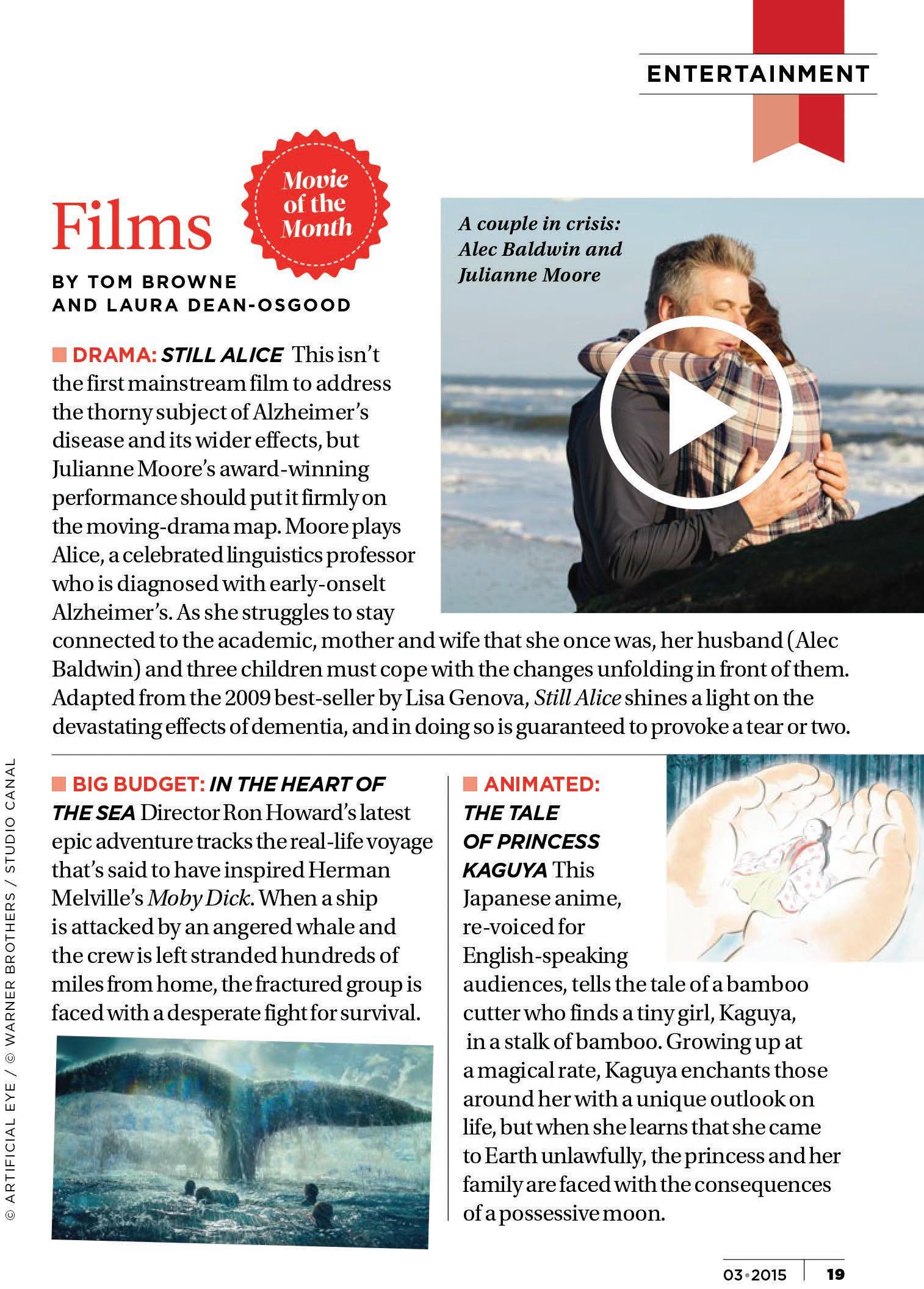

Canadian band Arcade Fire have amassed a huge amount of critical acclaim during their career, and multi-instrumentalist Will Butler—younger brother of frontman Win— has been a key member from the start.
Now he’s delivered his first solo album and, like Arcade Fire, it’s catchy, danceable and lyrically rich, with enough points of departure to keep it interesting. But although Will proves his individual talent, it isn’t long before you start comparing him to his brother. Along with the vocal similarities, Policy feels like excess material from Arcade Fire’s 2007 album Neon Bible. While such an accolade would be welcomed by many debut artists, you imagine it’ll become frustrating as the reviews start to roll.

Key tracks: “Anna”, “What I Want”, “Witness” You may also like: Arcade Fire, Bruce Springsteen, Architecture in Helsinki
overlooked record from the Past
midnight cleaners by Cleaners from Venus

When Martin Newell formed CFV, he turned his back on music convention, ensuring that 1982’s Midnight Cleaners became one of the finest outsider albums ever. Initially released on cassette, the album, in keeping with the band’s DIY ethos, was self-distributed—often in exchange for an addressed envelope and a blank tape.
Today, however, you can find CFV on iTunes. Clearly the work of a music obsessive who’d locked himself in his room with nothing but instruments for the best part of a year, songs such as “Only a Shadow” ooze power-pop genius with a lo-fi postpunk aesthetic.
On Our Radar
falmouth spring festival, mar 12-29, Celebrate the arrival of spring in true Cornish style.
Photography show, mar 21-24, Love taking pictures? Head to Birmingham NEC bath Comedy festival, mar 27apr 6 Lots of laughs in historic Bath.
Actor Charmian Carr, 72, shot to fame as Liesl, the eldest von Trapp daughter, in The Sound of Music, which celebrates its 50th anniversary this month
…I was born I n Ch IC ago just after ChrIstmas In 1942, but one of the first things I can recall is eight years later. I wanted to play with my baby sister Darlene, so I lifted her out of her bed when she was supposed to be having a nap. When my mother came in, she thought Darlene had climbed out of her crib by herself. She was very impressed, given that she couldn’t yet walk.
…hardly ever see I ng my parents. My mother Rita K Oehman was a vaudeville star who’d made her name as a child, singing and dancing
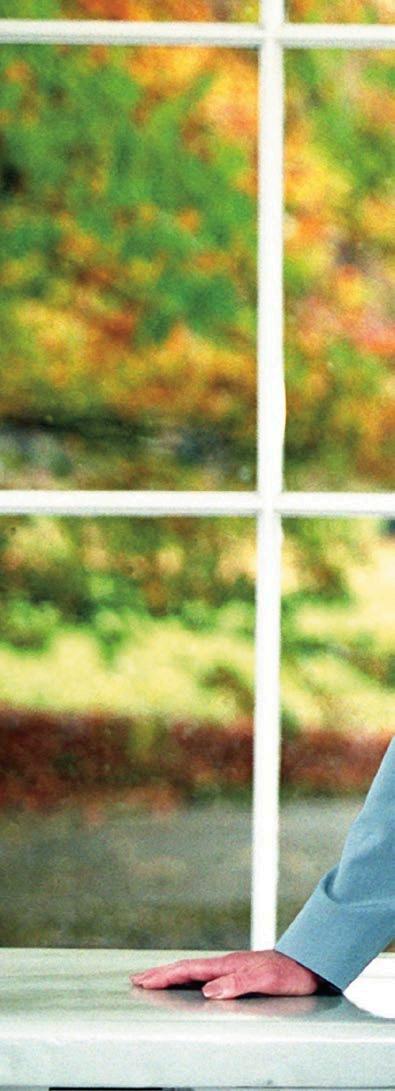


with her brother Edward. They called themselves the Oehman Twins. She’d then gone solo. My dad Brian Farnon was the leader of an orchestra. They were always working, so it was left to a lady called Johnnie to look after us.
…stIll feelIng sad when they dIvorCed. I was 13 and we’d moved to California, not far from Hollywood. My mum was pretty bitter and drank a lot. After my dad moved out, he never came to see us again. Things were pretty tough for me and my sisters, but we supported each other. I didn’t meet my father again until I was 21, when I saw him perform with his orchestra.
…I loved to dan C e. I was good at it too, particularly ballet. I’d win competitions at school. My favourite teacher was Stan Kramer. He taught me to laugh and relax while I performed.
…my mum got me an audItIon for The Sound of MuSic wIthout me knowIng. The filmmakers were struggling to find someone suitable to play Liesl—she had to look young and innocent, but still be able to convince the audience in the romance scenes. So they’d asked the Hollywood agent Marian Garner to find someone. She was friends with my mum, who thought I could pass for 16 even though
I was 21, and put me forward. I’d never acted, danced or sung professionally. I was at college and working part-time for a doctor.
I’ve no idea why the director Robert Wise thought I was right for the part. I could sing and dance well enough, but I think they’d just run out of options! And the rest of the cast were two weeks into rehearsals when I was hired, so I had a lot of catching up to do. I never really thought I was a good actor.
… f I lm I ng the “m y favourIte thIngs” song I n the C h I ldren’s bedroom. It was exciting because it was the first scene we did. But doing “Do-ReMi” in Salzburg was fun because we were dancing to the music and, well, I loved to dance!
was adrenalin because I carried on dancing for three days with very little pain and finished the scene. The crew gave me a standing ovation.
...almost puttIng my baCk out havIng to lIft gretl, the youngest of my von Trapp siblings, at the end of “So Long, Farewell”. Kym Karath, the actress playing her, was only five, but she’d basically eaten all the food on the set. It’s been said that she doubled in weight, and that sounds about right. Christopher Plummer was supposed to carry her up the mountain at the end, but he had to use a stunt double.
“The cast were two weeks into rehearsals when I was hired, so I had a lot of catching up to do”
…nearly break I ng my ne C k wh I le f I lm I ng the “ sI xteen g oIng on seventeen” sCene. At one point, during what’s supposed to be a tender dance number with Liesl’s suitor Rolf, I had to jump on a bench in the gazebo. The wardrobe department had put me in shoes without rubber soles and I skidded and went straight through a glass window. My ankle was cut and sprained, but rather than take me to hospital, the crew bandaged me up and gave me an injection of what they called “Vitamin B12”. I suspect it
…be I ng suddenly famous. After filming finished I was still under contract with 20th Century Fox, and they had me touring all over the world for the best part of two years, promoting the movie. I went to all these exotic places I’d never been, such as Asia and the Caribbean, and was given VIP treatment everywhere I went. The rest of the von Trapps and I appeared on The Ed Sullivan Show in April 1965. It was amazing to be on a TV series I’d grown up with.
… s tephen s ondhe I m. He wrote the music for Evening Primrose , my first project after The Sound of Music in 1966. It was a one-off hour-long
O cial partner of Red Nose Day specsavers.co.uk
Open on Sundays, check online for details

Applies to one pair of glasses, from £69 range or above. Includes all frames, lenses and Extra Options. Excludes reglazes, safety eyewear, contact lens products and non-prescription sunglasses. Cannot be used with other o ers. Discount not transferable in whole or part for cash. Free eye test funded by the NHS. SKUs 25664249, 25664294. ©2015 Specsavers. All rights reserved.





TV musical, and I played a young girl called Ella Harkin. Sondheim wasn’t that well-known yet, but he’d do amazing things such as pen a new song for me in a night. I got to perform wonderful compositions such as “When” and “Take Me to the World”, and also duet with Anthony Perkins.
…turn I ng my baC k on aC t I ng for my famIly. I married a dentist called Jay Brent in May 1967, who I’d met when he fixed my teeth. Soon we had two daughters, Jennifer and Emily, and I wanted to stay at home with them. So I quit acting and just did the odd commercial. I guess my childhood had made me a more sensitive adult —I wanted to be the sort of parent my mother and father had failed to be.
… The Sound of Mu S ic I nsp I rIng a new C areer. I’d been hugely impressed by the sets on the film, such as the inside of the von Trapp house. The production designer Boris Leven had a terrific attention to detail. So, in the late 1970s, as my family got a little bit older, I decided to become an interior designer.
…a partICularly InterestIng
C l I ent. I worked for several Trapp sisters, including Brigitta and Louisa, but the best known was Michael Jackson. I worked for him for eight years, designing his homes before Neverland. He was eccentric—he wanted a whole lot of mannequins in his bedroom and no furniture. But he was warm, and I loved and respected him.

Jersey brims with unforgettable places waiting to be explored. Tranquil places like Elizabeth Castle, perched on a rocky islet in St Aubin’s Bay, the island’s defence for over 400 years. Magnificently preserved places like Mont Orgueil Castle and mysterious places like Neolithic La Hougue Bie, one of Europe’s finest ‘passage graves’. Thought-provoking places such as the award-winning Jersey War Tunnels, which tells the story of the five-year German Occupation and the ever-present remains of coastal fortifications built by Hitler as part of his ‘Atlantic Wall’. Add a mild climate, easy travel by air or sea from the UK and great-value o ers, and you’ve discovered Jersey. jersey.com





mIC hael tak-
…
I ng me and my daughters to dIsneyland. They were about 12 and nine at the time, and he treated them to all the rides. But he was like an older child to me, very playful and fun. In September 1984, he flew us in his private plane to a Jackson Five concert in Philadelphia— part of the Victory Tour. We were right in the front row!

…havIng to keep shtum. I don’t have too many stories about my other celebrity clients. I always had to be discrete about their lives. These people were letting me into their homes and had to know they could trust me.
…gett I ng ba C k together
w I th my ons C reen fam I ly on tv. There was this big cast reunion on The Oprah Winfrey Show back
in October 2010, including Julie Andrews and Christopher Plummer. It was the first time I’d seen all of them in years and it was brilliant to be reunited. They had certainly changed a lot since 1965, Kym Karath in particular. She isn’t a clumsy five-yearold any more—she is a sophisticated woman now.
...the really pos I t I ve effe C t
The Sound of Mu S ic has had on my l I fe. I’ve been able to travel, write books, launch a successful design career…all the interesting things I’ve managed to do. It’s been a very happy life.
As told to Simon Hemelryk
The Sound of Music 50th Anniversary Edition is available on Blu-ray, dVd and digital hd from this month
oh, the irony!
“School Two Easy For Kids.” headline seen on nbc news about the state of education.
“Reliability...always upholding the highest standards for every detal.” extract from a printers’ marketing material.
source: BuZZFeed.com


Seven common medical conditions that may be causing you to feel fatigued
are you tired or S ick?
“I felt as though lIfe was beIng sucked out of me,” says leslie pitcher.
it was unusual for leslie, who at 41 was fit and healthy. the single mum from blackpool visited her doctor several times during 2010, but nothing was found to be amiss. then she began to have additional problems: her joints stiffened, she gained weight and her emotions were all over the place. “underlying everything was the constant lack of energy,” she says.
dr rupal Shah, a gp in south london, says tiredness is one of the most common complaints she sees in her office. if you’re feeling tired for no good reason, don’t ignore it.
“Most of the time, fatigue is linked with mood
and
the accumulation of lots
of little stresses in life,” says Dr Shah. “But
your
doctor
can
rule out anything serious, and just knowing there’s nothing wrong can be reassuring in itself,” says Shah. “And, if there is an underlying condition, the sooner it’s treated the better.”
By January 2012, Leslie had reached the end of her tether. She went back to her doctor demanding that something be done. He sent her for a full blood screen. It came back positive for hypothyroidism, a condition where the small thyroid gland in her neck, which makes and stores hormones, produces too little thyroxine for the body to regulate heart rate, blood pressure, temperature and convert food to energy—leaving a person drained and tired.
Leslie immediately started taking thyroid medication and today her
weight is stable and her joints are no longer stiff—and her constant feeling of fatigue is a thing of the past.
“If you’re persistently tired for longer than a week and are suffering from other symptoms as well, such as weight gain, constipation and slow metabolism—general sluggishness— ask to have your thyroid checked,” says Dr Kristien Boelaert, a consultant endocrinologist at the University of Birmingham. “Fatigue is the most common symptom of an under-active thyroid, and if left untreated it will only worsen.”
“In spring 2012 when I was just 41 years old, I started to feel physically drained,” says Kjell Mathiassen. “I wanted to crawl into bed.”
The hospital administrator from Sandnes, Norway, was perplexed. He’d always been sporty, plays volleyball and football and enjoys being with his
two active young sons. But soon even leaving the sofa to walk his dog became a struggle.
When Kjell went to his doctor, he was told to relax more. No blood tests were taken. Throughout the summer his fatigue increased and then he started to gain weight and run out of breath when he exerted himself.
“I was fed up and frustrated. That September I went to our local hospital and demanded a full blood check-up.” That, and a subsequent scan, revealed that he had serious heart problems. “I was devastated,” says Kjell.
His heart was enlarged—a sign it was working too hard—and functioning at only 13 per cent of its potential. This was the cause of his fatigue. Kjell was put on medication and within a couple of months his heart was working at 50 per cent of capacity, an acceptable rate, and there’s no reason he can’t live a normal life.
“Fatigue is a hallmark of heart failure,” says Kenneth Dickstein, professor of medicine at the University of Bergen, Norway, and founder of Heart Failure Matters, an international website on heart medicine. “Inability to perform normal tasks or exercise intolerance is frequently reported to doctors as tiredness. It’s important they recognise this may be the first presenting symptom leading to a diagnosis of heart failure and investigate.”
Kjell Mathiassen is now back leading a full life. “This has taught me how important paying attention to changes in
your health can be,” he says. “I’m not ready to leave my family yet.”
Fifty-two-year-old Sabine Badge, head of a nursery school in Hattingen, Germany, was used to having lots of energy to engage her young students. Then in the autumn of 2002 she began to suffer unexplained muscle pain and extreme fatigue.
“All of a sudden, I’d feel exhausted without any reason,” says Sabine. “Sometimes, too, I’d have symptoms
Part of the Problem is that many doctors aren’t familiar with cfs, and itS cauSe iS Still unknown”
similar to flu.” For over a year she went to different doctors and underwent a variety of tests, including wideranging blood and urine tests as well as those for thyroid problems and Lyme disease. These ruled out a variety of possible health problems and in 2003 she was finally diagnosed with Chronic Fatigue Syndrome (CFS).
“CFS is very difficult to diagnose as there isn’t a specific test for it, and patients suffer many different symptoms,” says Professor Carmen Scheibenbogen of the Institute of Medical Immunology
at Berlin Charite Hospital. Sabine, for example, also suffers from fibromyalgia and multiple chemical sensitivity. “Part of the problem, too, is that many doctors aren’t familiar with CFS,” says Professor Scheibenbogen. “Its cause is still unknown. Most often it begins as a reaction to various infections.”
Sabine has been treated for the past six years with orthomolecular medicine —high doses of vitamins, minerals and hormones. Every day she takes vitamin B12, vitamin C, magnesium, omega-3 fatty acids and acetylsteine and glutathione infusions.
“I feel better, but the symptoms never completely disappear,” says Sabine, 64 and now retired. “I’ve joined a CFS self-help group and we share information on new treatments and medications. This helps me a lot.”
About ten years ago Hanna Lilius, a 46-year-old research secretary from Pirkanmaa, Finland, started to feel melancholy. Gradually she developed other symptoms; she cried a lot, she forgot things, she reacted impatiently to her family. And she was extremely tired all the time. “Even small problems felt like mountains to overcome,” she says.
Her fatigue and other symptoms finally interfered with her work and her home life. When her doctor diagnosed depression in 2013, she was surprised. “I didn’t know being tired was a symptom of depression.”
From then until the spring of last year, Hanna visited a psychologist and a psychiatrist in a programme tailored to her needs and was sporadically off work. She was also prescribed anti-depressants.
“Finally, thanks to professional care and medication, I was able to return to work in November last year,” she says. “I’m feeling much better now.”
“Depression is always a many-sided problem with varying symptoms,” says Dr Seppo Hietanen, a psychiatrist
dePression is always a many-sided Problem with varying symPtoms, and fatigue iS one”
at the Mehiläinen Medical Centre in Helsinki. “Fatigue is one of the insidious symptoms of depression. Individually tailored treatment is available, so that patients can return to work and continue their lives normally.”
“When I first started to experience serious fatigue more than 20 years ago, I was very concerned—as you can imagine, considering I’m a bus driver in the city of Gothenburg,” says 55year-old Swede Meir Ivgi. “I had feelings of suffocating when I was falling asleep, which made me panic and
wake up again. I went to many different doctors, but none had an answer.”
Meir had his tonsils removed in 1994 and that helped for about a year. But then his problems returned. Finally, three years later, he was referred to a sleep apnea clinic where he spent the night under observation. The diagnosis came back positive; Meir had the condition. As sleep apnoea expert Jan Hedner at Sahlgrenska Univeristy Hospital explains, “While someone with the condition sleeps, his upper airway sags and periodically collapses. This causes hypoxic episodes and keeps him from falling into a deep and restful sleep.”

But at the time it wasn’t considered severe enough for him to be given a breathing mask, a device that increases air pressure in your throat so that your airway doesn’t collapse when you breathe in while asleep.
“My continued fatigue had huge consequences on my life. I had to sleep longer and longer, but that didn’t help,” says Meir. “As time went on, it just got worse.”
Finally, about seven years ago, Meir heard about a sleep apnoea study at the city’s Sahlgrenska University Hospital. He applied to take part and
it was here that he was finally able to try out a sleeping mask. He now uses it full time.
“I sleep millions of times better than before. My quality of life has improved and I no longer fear falling asleep at the wheel,” says Meir.
Eight years ago, Larry Rainey and his wife Elaine sold their home in Markham, a suburb of Toronto, to move to their cottage in Ontario. The 62-year-old retired schoolteacher calls it a “rugged property,” surrounded by
deer and moose and birch, oak and maple trees. He and his wife love the country life.
But in November 2013, he started unaccountably to feel tired. “If I walked up a set of stairs, I was out of breath,” he said. “If I walked up a hill, it was almost impossible.” The fatigue was preventing Rainey from chopping
advice of his doctor, and he’s been proactive in eating foods rich in iron.
“There are over 100 different types of anemias,” says Marianne de BretanBerg of Southlake Regional Health Centre in Ontario. “When you don’t have enough iron you may have symptoms such as fatigue.”
there are over 100 tyPes of anemias. when you don’t have enough iron, you feel fatigued”
firewood for the winter and getting to the countless tasks necessary to keep the home maintained.
Then in April last year, in the course of preliminary tests for shoulder surgery to repair an injury, blood tests revealed he had iron deficiency anemia: his body lacked the iron needed to produce hemoglobin, the substance in red blood cells that helps circulate oxygen through the body. Further tests revealed that polyps in his stomach were bleeding, the likely cause of the iron deficiency. The surgery had to be delayed until his iron levels were brought back to acceptable levels.
Rainey had three iron transfusions before his surgery in late June last year. He also immediately started taking iron supplements and B12 on the
Rainey has felt his vitality return since the iron in his blood has been restored. “It’s given me noticeably more energy,” he says. “No problem now about going for walks in the country.”
French nurse Marie Christine Dubois, 54, had been tired all her life and no one could ever tell her why.
“As a young girl I loved sports but I always got more tired than the others,” says Marie Christine. “By the time I was 11, I would be so tired after a week of school that I spent the weekends trying to catch up on rest.”
She also suffered from stomach complaints and diarrhoea. When she was in her late teens, her family doctor thought her fatigue might be caused by anemia so prescribed iron tablets. This only made her stomach upsets worse. In her twenties, she suffered some immune problems, so her debilitating fatigue was attributed to that, then later to stress.
No one thought that her rural and fresh diet—which included French bread—could be the culprit. At that time gluten intolerance, otherwise known as coeliac disease, a common

Our fantastic invisible hearing aid is small. Really small. And, because it fits slightly deeper in the ear canal than your average hearing aid, it’s virtually invisible when worn. That means you get all the benefits of hearing better without anyone understanding how you do it.
Whilst it can’t be seen the difference can be heard.
Just because this hearing aid is small doesn’t mean it’s less effective. We’ve made sure this tiny device has the high speed processors and clarity enhancing features of the very latest hearing aids. These are the things that make sure you get to enjoy all the great things life has to offer like conversations with friends and family, an evening out in your favourite restaurant or a cosy night in front of the TV. And you can enjoy all this with the confidence that whilst people might notice the difference in your hearing they definitely won’t notice your hearing aid.
If you like what you (don’t) see, call 0845 203 7662 and book a free appointment in store to find out more about this amazing little hearing aid.
“I hear normally, it’s as if I don’t have a loss and, because you can’t see them, no one else knows I do!”

To book your hearing check simply call 0845 203 7662
Terms: Only one hearing check per year. Free hearing check for over 18s only. Subject to availability and eligibility. By appointment only. Call 0845 203 7662 (local rate, calls may be recorded for training purposes) between 8.30am and 6.00pm (Mon-Thurs), or 8.30am and 5.30pm (Fri) and 9.00am and 5.30pm (Sat).

autoimmune disorder caused by the reaction of the gut to gluten, was unheard of.
Then in 2001, aged 41, she consulted a doctor at the hospital where she worked. He ordered a simple gluten intolerance test. Sometimes patients experience symptoms similar to that of coeliac disease but tests come back negative. If this is the case, you may have gluten sensitivity, a separate disorder that doesn’t cause the small intestine damage found in coeliac disease. Marie’s test came back positive— she has coeliac disease.
“From that point on, everything seemed to fall into place,” says Marie Christine. “When I was a baby, my health log book noted the onset of
diarrhoea when cereals were introduced into my diet. I’d clearly been gluten intolerant since birth.”
“Fatigue is one of the most common symptoms of gluten intolerance,” says Dr Anneli Ivarsson, associate professor at Umeå University in Sweden. “If you’re feeling tired and low in energy, go to your doctor for tests. Don’t cut out gluten on your own initiative; always take the advice of a medical professional. Coeliac disease is a lifelong disease and gluten needs to be eliminated slowly.”
“I’ve made a lot of changes to my diet,” Marie Christine says, “but I lead a normal life. I have a small amount of bread every day. French bread is just too good to give up completely.”
a french court recently intervened to some stop chocolate-loving parents naming their child nutella, after the popular sweet spread. these names have also been banned around the world at some point:
mafia no fear (new Zealand)
Superman (venezuela)
anus (denmark)
Saddam hussein (brazil)
4Real (new Zealand)
robocop (mexico)
osama bin laden (germany)
linda (Saudi arabia)
mona lisa (Portugal)
As sEEn AT
HuffingTonposT.com
You are what you eat; the health of your body reflects your diet. Research shows the healthy benefits of the traditional Mediterranean diet, for example: those choosing it appear less likely to develop high blood pressure, high cholesterol or to become obese. Mediterranean cuisine is rich in essential fatty acids (EFAs) DHA (Docosahexaenoic acid) and EPA (Eicosapentanoic acid), called ‘essential’ because they cannot be made e ciently by the body and must be obtained through diet.
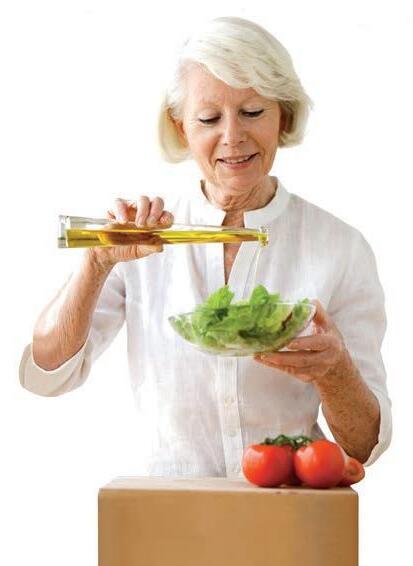
Key components of the Mediterranean diet, rich in EFAs, include: olive oil; protein-rich legumes; lots of fruit and vegetables; plenty of fish; moderate amounts of red meat and red wine.
To safeguard your intake of EFAs, it may also be beneficial to take a nutritional supplement. Vitabiotics Ultra Omega 3.6.9’s unique 3-in-1 formula provides the benefits of Omega-3, Omega-6 and Omega-9 all in one capsule. The Omega 3 fish oil used in Ultra Omega 3.6.9 is composed of high quality triglycerides, sourced from small fatty fish including sardines and anchovies, to provide a rich source of EPA and DHA. The fish oil undergoes a rigorous purification process; each batch is tested, certified and fully compliant with stringent EC and WHO rules on environmental pollutants.
Each 3-in-1 Ultra Omega 3.6.9 all-in-one capsule provides:
n Omega-3: from high-purity fish oil, produced in Norway
n Omega-6: from Blackcurrant Seed Oil and Pumpkin Seed Oil
n Omega-9: from Olive Oil (European Pharmacopoeia quality grade)

Vitabiotics Ultra Omega 3.6.9 (RRP £9.95 for 60 tablets) is available from Booand online at www.vitabiotics.com and





Susannah is twice winner of the Guild of Health Writers
Best Consumer Magazine
Health Feature
EvidE ncE for thE bE nE fits of a Mediterranean diet—rich in fruit, vegetables, olive oil, fish and poultry— is growing. The very latest research shows that:
■ A Mediterranean diet may lower levels of platelets and white blood cells, according to an Italian study. These are markers of inflammation, which is linked to greater risk of heart attack and stroke.
■ It could guard against type-2 diabetes. This was the conclusion of a study of 3,500 older adults at high risk for heart disease, while a review of 19 studies covering 162,000 people over five and a half years found that the Med diet was associated with a 21 per cent lower risk.
■ It may cut the risk of cardiovascular disease in young working adults, according to an American study.

■ It appears to keep you young. Researchers in Boston who followed the health of 5,000 nurses over a period of ten years found that those who ate the Mediterranean way had fewer signs of ageing in their cells. So it could well be the recipe for a long life.

Not already a devotee? Start by choosing quality over quantity and eating smaller portions more slowly. Favour wholegrain foods, such as wholemeal bread and brown rice, over refined products such as white
bread. Eat more nuts, seeds and dried fruit and less red meat. Swap processed and fast foods for fresh and freshly prepared ingredients, and replace sugary puddings with fruit-based treats.
When life gets busy, exercise is usually the first thing to go. But that could be a mistake. Working out regularly can make you more confident about balancing home life and your job, according to a study published by Human Resource

Management. Physical activity helps us detach ourselves psychologically from work and the stress that goes along with it, say researchers. Try planning your workouts a week in advance to make sure you make time for them.









If your days out are being ruined by too many visits to the toilet you may be su ering from an overactive bladder.
Over 7 million people in the UK su er too, so you’re not alone.
Luckily there are treatment options available including e ective medications from your doctor.
To find out more about overactive bladder and the help available visit
www.bladderproblem.co.uk
Or call our free helpline on 0800 011
4766












Being robbed of a good night’s rest? Here are five common sleep stealers:
1. your joB. Long hours, shift work, commuting and stress all take their toll on your sleep. Avoid bright light from screens in the evening—it suppresses melatonin, which helps promote sleep onset.
2. MEdicATion. Many medications have either stimulating or sedating effects. Talk to your doctor if you suspect a drug is keeping you awake.
3. sTrEss And AnxiETy. Make a list of what’s on your mind, with timelines for addressing the issues. When these thoughts recur later, remind yourself there’s a plan, then focus on sleep.
4. ALLErgiEs. Antihistamines or nasal sprays can improve your sleep quality, but avoid down or feather bedding and buy good-quality pillow and mattress protectors.
5. Food And drink. Caffeine after late afternoon can affect sleep. Booze may send you off, but then it makes you more alert when you least want to be. Warm milk, on the other hand, may help you get off to sleep.

1. seek out the sun. Fifteen minutes of sunlight on your skin every day will boost your levels of vitamin D and could cut your chances of this common male cancer.
2. go bowling with a friend. one study found that men with high levels of stress and few social contacts had higher levels of prostate-specific antigen in their blood, a marker for developing prostate cancer. Bowling, on the other hand, reduces stress.
3. sprinkle Brazil nuts on your salad. they’re rich in selenium, a trace mineral that can persuade cancer cells to zap themselves.
4. Eat raw onion. A diet high in onion may slash the risk of prostate cancer by 50 per cent. It’s most effective when eaten raw or lightly cooked.


Q
Ovarian cancer is rare, right?
So what’s my risk?
AWomen in the UK have a one in 54 chance of developing it, but the risk might be higher in some cases.
QDo you mean if there’s a family history?
AYes. Having relatives with ovarian and/or breast cancer before the age of 50, or with breast cancer before the age of 60, increases your risk.
QWhat other risk factors are there?
ABeing overweight, taking HRT, having endometriosis or

polycystic ovary syndrome can all raise your risk. And smoking also makes ovarian tumours more likely.
Q
Can anything cut my chances of developing ovarian cancer?
AYes. It’s not all doom and gloom. Using the combined oral contraceptive pill for five years halves your risk. Other types of hormonal contraception such as the minipill and contraceptive implants may also protect you, as may breastfeeding.
toothbrushes are 7,000 years old! the first was a “chew stick” made of wood, while the chinese created a brush using hog bristles around 1500. We’ve come a long way, but the latest trend in teeth cleaning, oil pulling, is actually a 3,000-year-old Ayurvedic practice. It involves swishing coconut, sesame or sunflower oil around your mouth to loosen debris and control plaque. But does it work? A few studies support the claims, but their evidence is quite weak, so it’s best you continue with regular brushing and flossing.

Max is a hospital doctor and author.
He’s also the resident doctor on ITV’s this Morning
Hospital food isn’t renowned for being particularly appetising. On our ward, though, it isn’t what’s on the menu that’s the problem—it’s what isn’t on it.
Poor Mrs Leslie, as well as having the beginnings of dementia, has a list of medical problems. She’s 82-yearsold and her appetite isn’t good at the best of times, but she loves fruit. She’s taken to hiding bananas under her pillow, and is so upset when she thinks someone has taken hers that we can hear the noise in our ward round.
We all peer out of the office and into the lounge. “You’ve eaten it already,” one of the nurses is trying to explain.
“I haven’t, he’s taken it,” she shouts, pointing to Murray. Everyone looks at Murray.
“I never touched her bloody banana!” he shouts back.
“Don’t worry,” says my consultant Dr Webber. “We’ll get you another banana.”
He’s greeted by an embarrassed silence.
“Erm, no, we can’t, I’m afraid,” says one of the nurses. “We’ve had all the ones we’re allowed for today. That’s why she hides them under her pillow.”
The shortage of fruit on the ward, the nurse goes on to explain, is because the Trust has recently decided it needs to make cutbacks. One of the significant causalities is the

food budget. How anyone can justify withholding fresh fruit from sick people is beyond me. Our ward, where there are 15 patients, is allowed just three bananas a day.
The ward also gets two apples a day, but as most of the patients have dentures or bad teeth, they’re traded with other wards for more bananas. An orange has yet to make an appearance—they’re obviously out of our league. It’s got so ridiculous that some patients take their portion of banana into the toilet with them, in case someone eats it while they’re away from the dinner table.
Here’s a group of people for whom fresh fruit would do the world of good, who actually want it—who are in fact clamouring for it—but for whom it’s being rationed. You’d be
forgiven for thinking we’re still fighting the war.
Dr Webber is furious. He quite rightly points out that the patients in hospital are wholly reliant on what’s served up to them at mealtimes to provide the vitamins, nutrients and energy needed to get better.
Few of them have visitors who will bring them food, so Dr Webber returns the next day with a basket of fruit, paid for by himself. Mrs Leslie is beside herself with excitement.
“I’m not going to let this lie. It’s a disgrace,” he fumes, at which point Mrs Leslie bursts into applause.
He then leaves the ward to find the hospital managers. I suspect it’s going to take more than an apple a day to keep this doctor at bay.

WHere did tHe
mytH come from?
This myth inevitably uses various bits of pseudoscience to back up the claim. The most common is that antiperspirants prevent sweating and therefore there’s a build-up of “toxins” in that area of the body that leads to an increased risk of cancer. There’s also some confusion between sweat glands and lymph glands, with the suggestion that stopping sweating causes a build-up of lymph, which
can also result in cancer. In reality, sweat glands and lymph glands are entirely different things.
WHat’s tHe trutH?
There’s not a single published study that links antiperspirant use to breast cancer. In fact, studies of large groups of people have shown that the link doesn’t exist. Studies have also looked into the use of underarm antiperspirant or deodorants soon after shaving under the arms, and found no link. Likewise, there’s no evidence to show that chemicals in antiperspirants, such as aluminium or parabens, are linked to breast cancer.
so, tHere’s notHing to Worry aBout?
Breast cancer is, of course, a very serious topic that women should be aware of, but it helps no one to unnecessarily worry women over using a product like antiperspirant. So wear your antiperspirant if you want to, no sweat.











































How the soundtrack of my childhood drew me closer to my dad at a crucial time
It was October 2012 and I was about to do the first set at the Spice of Life in London’s Soho. My theme was songs with littleknown verses (in jazz this means intro), and I’d been researching and practising the arrangements for weeks. I was opening with “Lady Be Good” and I was nervous and excited. I knew the keyboard player and the guitarist, but I’d never worked with the drummer, who was from New York.
It was my most prestigious gig yet, the club was packed (with friends and colleagues in the audience) and there
was a huge knot in my stomach. The club’s manager came on and did two numbers to warm up the audience, then my name was called. This was it! Feeling good in my new figure-hugging low-cut blue dress, I stepped onto the stage, grabbed the mic, counted in the band and we were off.
It went well—so well, in fact, that I didn’t want to stop. The only thing more that I could have wished for was that my darling old dad had been there.
It’s 1969 and we’re gett I ng ready for sunday lunch. I’m ten. My mum Madge is laughing, gin and tonic in one hand, carving knife in the other. The smell of roast beef comes wafting through from the kitchen, and my dad John rests his pipe between his teeth as he puts an LP on our record player—usually Ella Fitzgerald or Louis Armstrong, sometimes Sarah Vaughan.
My white-haired gran Ada is sipping a Guinness, raising her glass to no one in particular, toasting, “May these be the worst of our times.” It’s one of my favourite childhood memories of the five of us in our cosy little house in Eltham, south-east London.
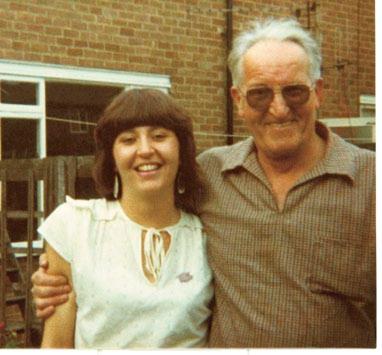
Lynne
Jazz was the soundtrack to my childhood, associated with good times, family parties and lazy Sundays. My dad loved Ella and Louis in particular, especially when they sang together on glorious tracks such as “I’m Putting All My Eggs in One Basket”. While my older brother Stephen raved about The Stones and Jimmy Hendrix, I was begging dad to play Ella’s “With a Song In My Heart” just one more time.
I remember getting severely told off at my strict all-girls grammar school for writing the capital of France as Paree , which is how it was spelled on the music charts for one of Ella’s songs. I adored Frank Sinatra singing swing, which was deeply uncool in 1970. I must have been the only girl in my class whose toes tapped to “I’ve Got You Under My Skin” instead of the Bay City Rollers.
Dad had bought a Hammond organ as a hobby for himself when I was
12 and I learned to play, having already been taught how to read music at school. I seemed to have a natural instinct for jazz, and as a tall kid with long legs I could just about reach the pedals.
Looking back, I don’t think I was ever going to be Diana Krall or Norah Jones, but I had some sort of talent—what musicians would call a good jazz feel. I remember learning “Lover Come Back To Me” in about an hour—the chords were easy—and being thrilled by the melody and the lyrics of Glen Miller’s “Moonlight Serenade”. To me it was a beautiful sound, and this big-band hit had far more meaning for me than the pop songs of the day.

“I had some sort of talent—what musicians call a good jazz feel”
My dad, who had a TV shop, wasn’t a natural keyboard player and was somewhat in awe of my skills, while I took it in my stride like a typical 12-year-old. I gave recitals at our local keyboard store and gathered quite a crowd as my dad beamed with pride. I remember getting a kick out of playing “How High the Moon” at breakneck speed. I also occasionally sang in concerts at the holiday camp we went to, and while my voice was in tune and in rhythm, I never thought it sounded particularly good.
My dad was somewhat in awe of my keyboard skills, while I took it in my stride like a typical 12-year-old
a s I d I scovered make-up, boys and discos around the age of 15, my love of jazz and swing from the 1930s and 1940s didn’t withstand competition in the form of David Bowie and Marc Bolan, and my passion for jazz dwindled. I listened to Billie Holiday and Nina Simone during my 20s, but it was just a latenight thing, not my main musical interest. Then, in my mid-30s, a guy I was dating put a Chet Baker album on one evening. It was the start of my jazz rebirth.
I adored the sound, thinking initially
it was a female voice, not knowing then that Chet was known first and foremost as a trumpet player. I was out of touch with the genre, but I found it hadn’t lost its magic for me. Listening to tracks like “Time After Time” and “Let’s Get Lost”, I would literally be transported to another place, totally blissed out as the music enveloped me and soothed my soul.
I bought all of Chet’s albums, along with those of Sarah Vaughan, Anita O’Day and June Christy. I occasionally sang along, but not in any serious way. I’d rediscovered the music of my youth and my dad was very happy about it. We had something in common again.

“Over time, I learned how to control the sound that came out of my mouth”
then, I n 2002, I went on an arts hol I day to Skyros in Greece that changed my life. I signed up for singing classes with Tom Robinson, of “War Baby” and “2-4-6-8 Motorway” fame. We sang mostly in a group, harmonies to classic songs, and on the last day we sang individually.
It was blisteringly hot and I sang, appropriately, “Summertime”. I don’t know how it happened, but I felt very relaxed as soon as I started singing and I strayed from the melody and improvised quite a lot of it. To my surprise, it sounded OK—I must have learned more from listening to my jazz albums
than I’d realised. Tom said that I should have singing lessons when I returned to the UK; “Summertime” was just the start of what I could achieve. He invited me to sing backing vocals in his concert that evening.
I booked into classes at the Blackheath Conservatoire in south London when I got home, run by the awesome jazz singer Jenny Howe, who held the only jazz residency in London, at the Ritz, for many years. I was nervous during our first class—my hands shook as I held the music and my voice warbled and sounded dreadful. Over time, I learned how to control the sound that came out of my mouth and how to give it power through breathing properly. Jenny taught us how to sing jazz standards competently, then we worked on making the songs our own. From 2002 until my last class in 2008, I learned how to put a song across, to improvise,
while Jenny ironed out my faults and got rid of all traces of “pub singer”.
In autumn 2002 the students put on a concert, and my dad beamed with pride as I sang “When Sunny Gets Blue” and “Do Nothing Till You Hear From Me”. He said afterwards that he could hear the Ella influence in the way I vibrated my voice at the end of a phrase.
“I’ve got you to thank for that, Dad,” I told him. “I’d never have known about Ella if you hadn’t played her when I was growing up.”
work that gave pleasure. He got a huge kick out of hearing me belting out all the old standards we’d enjoyed during my childhood, and it drew us together in his final years.
Dad got a kick out of hearing me belting out the old standards. It drew us together in his final years
Dad never got over me giving up keyboards as he’d been convinced I had a special talent. But he was delighted that I’d rediscovered the genre, that I could sing jazz and, most of all, that I adored it. Dad had always had hobbies—he appreciated the importance of having something absorb-
It’s as well that my dad came to hear me when he did, because he was diagnosed with kidney cancer in 2003. He died in May the following year, at home with his beloved Louis Armstrong playing in the background and mum and I holding a hand each. Jenny Howe had become a friend and she sang some of dad’s favourites at the funeral, including Armstrong’s “The Home Fire”, with our class pianist on keyboards and the esteemed Dick Pearce on trumpet. It sounded utterly gorgeous and heartbreaking, and I knew dad would have loved it.

“Dad was delighted I’d rediscovered the genre”
Mum and I were united in our grief, hardly able to believe he’d gone. She came to quite a few of my gigs and some of Jenny’s until she became wheelchairbound five years ago, and she sang along with every single tune. After all, it was the music of mum’s youth too.
I took an eight-week jazzvocals masterclass, made an album, sang at open-mic nights and scrounged guest

 Grosvenor 3 seater sofa
Grosvenor 3 seater sofa
spots at other people’s gigs. Then I finally got my own gig at a pub in Greenwich after a friend’s husband, a publican, heard me singing on the way back from a party in the back of a taxi one night. I was thrilled. I began singing at various other venues in southeast London, and I got a regular gig on cruise ships that sailed up and down the Thames. It was terrific fun, and I couldn’t believe how far I’d come.
I occasIonally wonder what would have happened if I’d kept up with the keyboards, whether I’d have been able to accompany myself, but I don’t think I was ever that good. I just feel extremely fortunate to have shared an appreciation of jazz with my late dad, without whom I don’t think I’d be enjoying a second career as a semi-professional jazz singer that

Lynne today. “Jazz is in my bones”
kicked off when I was 47. Jazz music is in my bones because I grew up with it and to it.
I never say it, but I often think when I sing one of his favourites, “The Lady Is a Tramp” or “Lullaby of Birdland”, Dad, this one’s for you .
smicker: to cast amorous glances at (1600s). “He couldn’t help but smicker his shiny new ipad.”
Groke: to look at somebody while they’re eating in the hope that they’ll give you their food (unknown). “if i keep groking at Kate, maybe she’ll give me the last of her brownie.”
bibble: to drink freely/intoxicating liqueur (1500s). “they still couldn’t believe how much Billy had bibbled at the office christmas party.”
Kench: to laugh loudly (1200s). “Kelly kenched on the train at the text she was just sent.”
SouRcE: thE
I100.INdEPENdENt.co.uk



From sweet and savoury to pork pies and clangers, we explore the glories of this traditional pastry-covered delight

The Befordshire Clanger is a delicious pastry with a twist—its contents are half savoury and half sweet. Traditionally it was a food for labourers, made from joint leftovers alongside jam or stewed fruit, steamed in muslin and taken by wives to their husbands. For some reason it fell out of popularity and was forgotten.
In the mid-Nineties, however, Bedfordshire’s own Gunns Bakery decided to reintroduce it to the masses, and since then it’s been on the up; even Jamie Oliver has got behind it. Gunns also created some lip-smacking new varieties to bring the clanger into the 21st century—one of our favourites combines beer and beef with rhubarb and custard in a single pastry!
■ Visit gunns-bakery.co.uk for details

The capital’s pie-and-mash tradition might be hidden behind masses of trendy pop-up food stalls and hipster cafes, but it certainly hasn’t disappeared. In fact, its historical legacy is everywhere—as culture minister Ed Vaizey says, “Pie-and-mash shops are

as intrinsically linked to London as black cabs and beefeaters.”
It’s no wonder that L Manze became the first such shop to gain listed status, securing its place in history. Walking through the doors into its “exceptionally complete interior”, in Vaizey’s words, is like taking a step into the 1920s, when it first opened. But it


isn’t just the furniture; the home-made meat pies, the mash and liquor (parsley gravy), the tills and even the serving methods are authentic.
So if you find yourself in the area, keep an eye out for these immaculate nuggets of local history—they’re still as delicious as ever!
■ Visit tripadvisor.co.uk for details

An icon of British football, this matchday pie has its beginnings in the midlands, where Shire Foods (a familyrun company founded in the 1970s) saw a niche in the footie market.
“A typical Friday for many young males is lager and a curry,” says one spokesman. “So if you get all that authenticity in a pie product, we thought it would work at the football.”
First sold at the home ground of Walsall Football Club, it’s now sold at over 60 clubs nationwide. This delicious combination of east and west is the quintessential modern British pie, and has since been adapted by numerous companies—from family favourite Birds Eye in the frozen aisles of supermarkets, to the slightly posher Pieminister’s thai pie found in trendy pubs across the country.
■ Visit famouspies.com for details
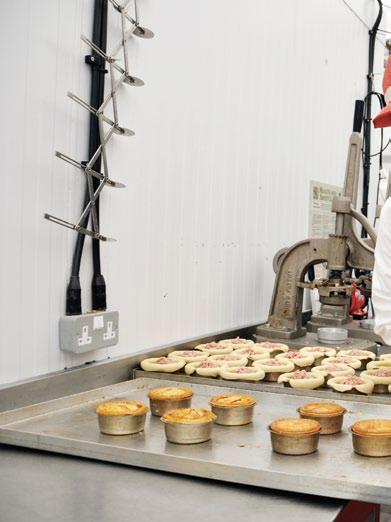
A hundred miles north of pork-pie capital Melton Mowbray reside a group of individuals who call themselves the Pork Pie Appreciation Society. From their humble beginnings as a group of friends relaxing in the pub every Saturday, the society has grown into a competitive beast. Each week, a member is selected to bring forth the pork pies— the pie-fetcher—and rest of the group keeps score.
“The amount of sauce used gives a good indication of how the tasting is going,” according to its website. “HP

sauce is a regular favourite to provide a little more taste, but should members reach for soy sauce or Worcester sauce, things aren’t looking good, and should anyone reach for Tabasco then the pie is likely to be considered a disaster.”
Butchers and bakers across the UK participate in the annual competition, taking place this month, eager to get their pies rated by the expert bunch. And with over 50 entrants, competition is fierce. One to reckon with is last year’s title-holder Hinchliffe Farm
Butchers—with three wins under their belt, can they make it a fourth?
■ Visit hinchliffes.com for details

If you like your pies served with a local legend, this is for you. The stargazy pie was reportedly created one stormy winter in the fishing village of Mousehole, Cornwall, in the 16th century. The waves were thrashing down so heavily that no fisherman could take out his boat, and the community were facing starvation. On December 23, fisherman Tom Bawcock finally braved the elements and brought back seven different types of fish, which were then baked into a huge pie.
This story is a little suspect—if they had the ingredients for a pie, were they really starving? Even so, Tom Bawcock’s Eve is celebrated locally on December 23 every year, and local pub The Ship Inn has kept the tradition of serving a large stargazy pie on this day.
■ Visit theshipinncornwall.co.uk for details










On winning the World’s Best Scotch Pie in January, Murrays, a small family bakery in Perth, has been inundated with letters, cards and flowers—all from lifelong customers. Murrays is an institution in Perth, and owner Linda is a fourth-generation baker.
“We’ve been going for 115 years, and
This creation was the winner of the Best Pie in Wales 2010, but it’s had a staying power beyond that competition and beyond the Cardiff pub that created it. Incorporating local ingredients, this pie is the epitome of Welshness in a pastry crust.
“I included leeks because it gave it more of a Welsh element, then I put in cheese because it’s local to Rosson-Wye, where I’m from,” says creator Adam Pavey. “It bridges the boundaries between England and Wales.”
the recipe we use was perfected by my dad almost 50 years ago,” she says. “I haven’t changed it one wee bit.”
As for what that recipe is, her lips are sealed. Scotch pie is traditionally made from mutton, but beef is more common now. The meat is mixed with rusk and spices, and it’s the spice part that Linda refuses to divulge.
■ Visit yelp.co.uk for details
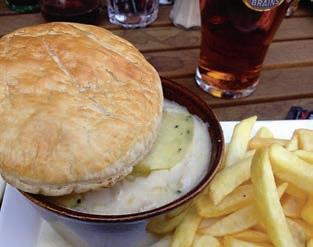
It certainly does—this recipe is now a cookbook staple.
■ Visit sabrain.com/goatmajor for details
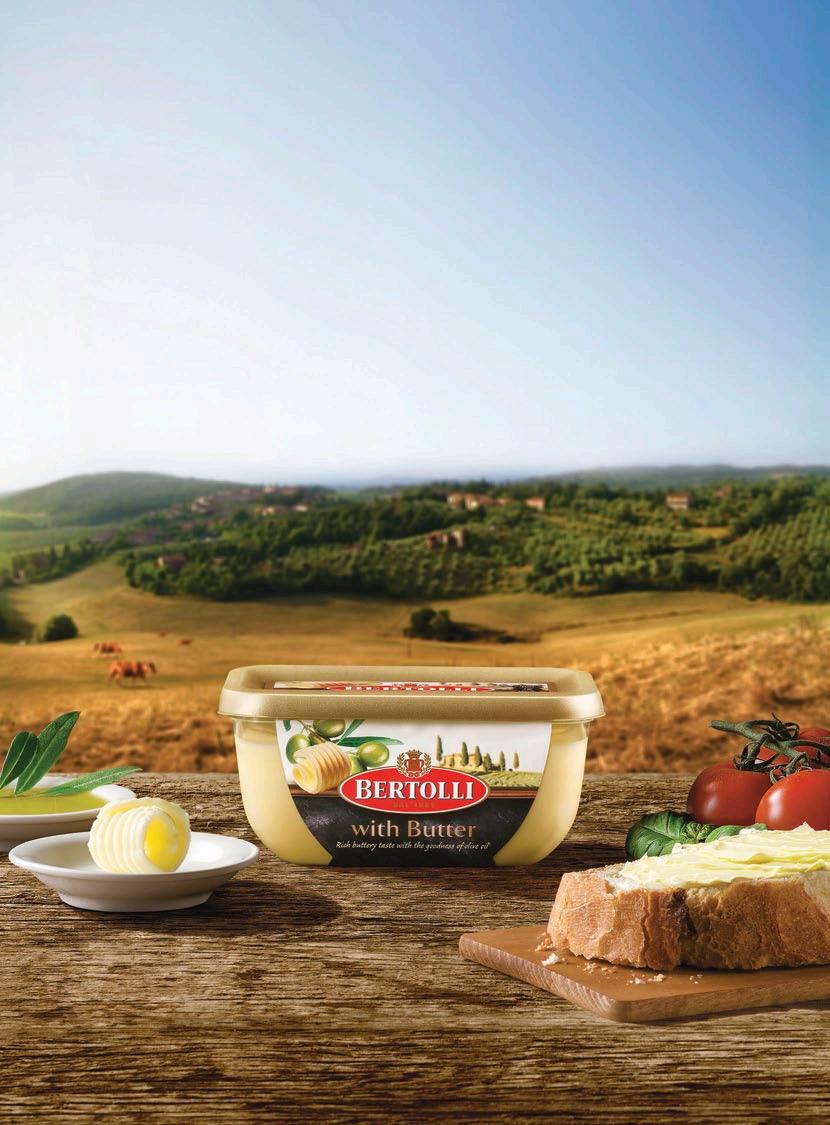
*Also contains vegetable oils.

Denby Dale is a village with a rather bizarre pie history. It all began in 1788, when locals decided to bake a huge pie to celebrate George III’s recovery from mental illness. Perhaps the king’s relapse was a sign of things to come— random incidents, such as a collapsed platform and a rancid pie that had to be buried, have dogged the tradition from the start.
That said, the pie in 1928 attracted 50,000 visitors and fed 20,000 people. And since 1788, they have also baked ten colossal meat-and-potato pies in celebration of, well, whatever takes their fancy, including the millennium.
The recipe consisted of three tons of

beef, a ton of potatoes and 22 gallons of John Smith’s bitter. And although it’s uncertain when the next festival will take place, the legacy lives on through individual-sized versions.
■ Visit denbydalefoods.co.uk for details
Is there a particular pie that whets your appetite? let us know by emailing readersletters@readersdigest.co.uk
The odds of surviving even the most serious plane crash are 76 per cent. The odds of being the only one left alive are infinitesimal. This is what it’s like to be the...
On June 30, 2009, French schoolgirl bahia bakari, 12, and her mother aziza aboudou, 33, were on board a packed airbus a310 on their way to comoros, a group of islands off the eastern coast of africa, to visit family for the summer. Minutes from landing, yemenia Flight 626 shook violently in the swirling 40mph winds; the lights flickered, the engine stalled and the plane, holding 142 passengers and 11 crew members, plunged into the indian ocean, breaking apart on impact.
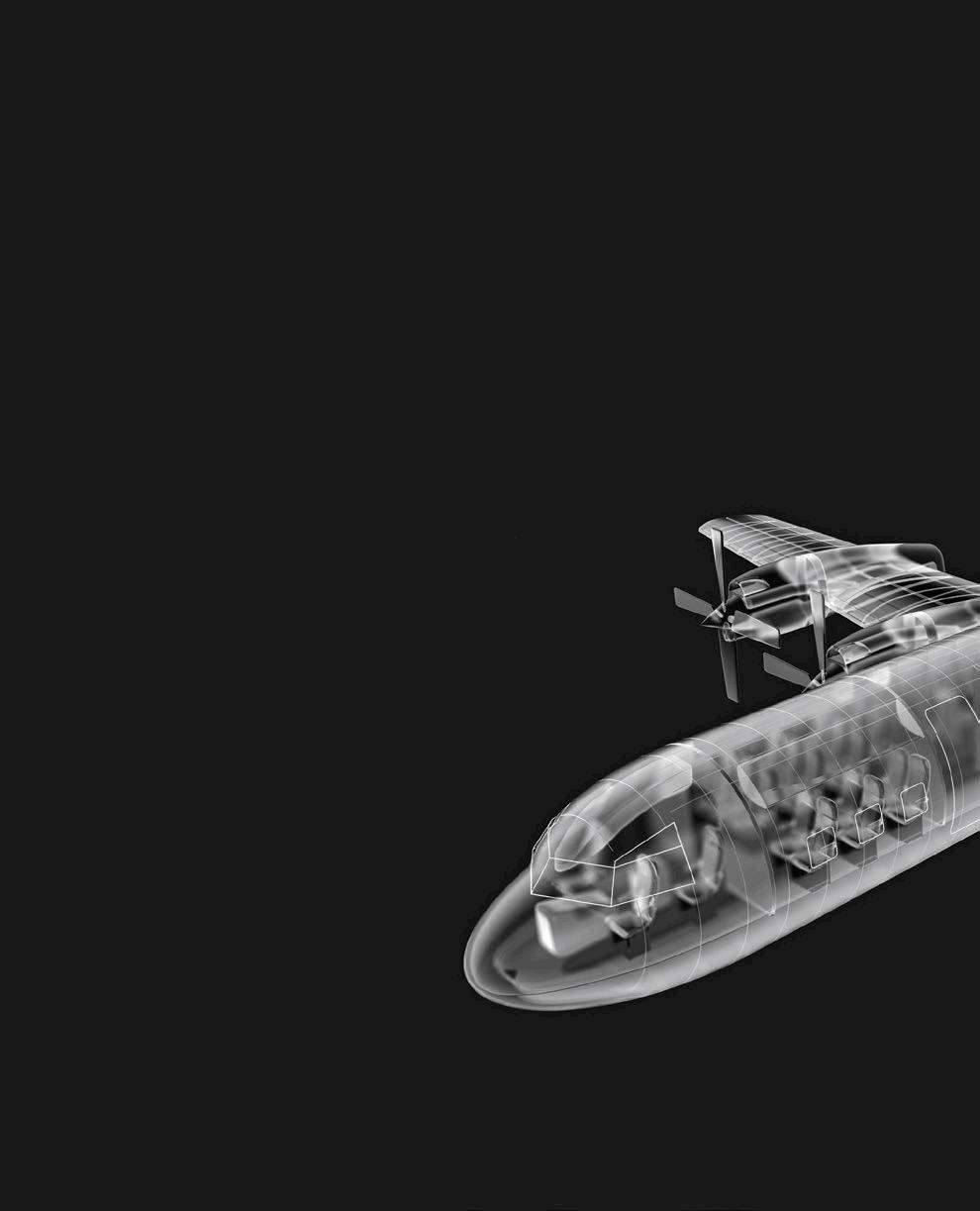

The illuminated area represents where passenger George Lamson Jnr (next page) was seated when the plane he was on crashed, killing 70 people


bahia was ejected from the plane. With no life vest, food or drinking water, she clung to a piece of wreckage for 13 hours until a sailor from a private rescue boat plucked her from the ocean. days later, as she recovered from her wounds in a paris hospital, a psychologist shared unlikely news: bahia was the only survivor of the disaster.
Call it a miracle, coincidence or luck—the distinction of being the only one left alive is a heavy weight, says Ky Dickens, 36, whose 2013 documentary film Sole Survivor tells the stories of several plane-crash survivors.
“They feel an incredible amount of pressure,” says Dickens, a survivor of a car crash in her teen years that killed several of her friends. Drawn to the topic partly because of her personal experience, Dickens contacted George Lamson Jnr— a passenger on a plane that crashed, killing everyone else on board, including his father—and enlisted him to help other survivors share their stories with the world. Says Dickens, “Naturally they wonder, Was I spared for a reason? Am I supposed to do something amazing?”
Here Lamson Jr and two sole survivors from other crashes, Annette Herfkens and Jim Polehinke, describe what they live with every day as members of a tiny club they never sought to be part of, but are very fortunate to have joined.
Date: 21/1/1985 FLiGht: Galaxy Airlines 203 From: Reno, Nevada to: Minneapolis on boarD: 71 Crew Deaths: 6 PassenGer Deaths: 64 The flight crew had significantly reduced power to the engine to eliminate unusual vibrations. The captain lost control of the aircraft, sending it plunging into a caravan site lot near downtown Reno.
After my fAther and I found our seats, I settled in and tried to sleep. Pretty soon, two men came up to us and said, “Hey, you’re in our seats.” That wasn’t true, but my dad said OK, and we switched seats with them. Our new seats were in the first row right behind a bulkhead.
After take-off, everything seemed smooth at first. Then we hit turbulence and the plane started to bank to the right. It didn’t seem serious, but as I was looking out the window, I could see we were losing altitude pretty quickly. Over the loudspeaker, the pilot said that we were going down. It must have been five to ten seconds before
we hit the ground. We hit three times, and the third time the plane hit a caravan site and broke apart. It was going about 140 miles an hour. I was thrown more than 40 feet onto a street near downtown Reno.
The wreckage was on fire and I searched through it trying to find anybody alive. One memory I can’t shake is of finding the man who took my seat. He was lying out in the field, facing the fire, and I could see his eyes were open. I went to him trying to help, but I realised he was dead. If I hadn’t switched seats with him, that would have been me.
After the ambulances arrived, they took me to the hospital with another survivor. He had third-degree burns all
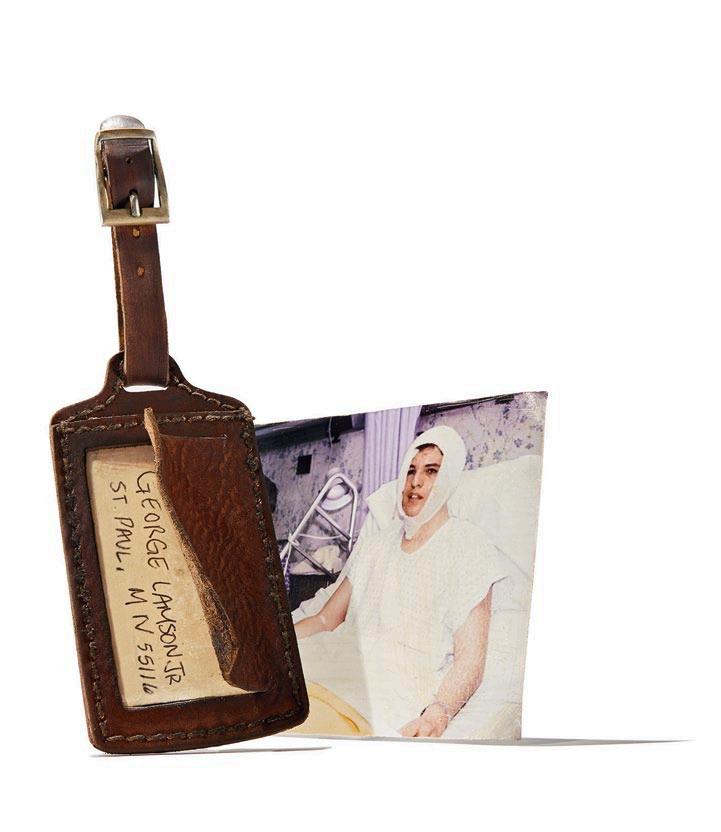
over his body. His skin was black from the fire. I said to him, “I can’t believe I couldn’t find anybody. Here we are, still alive and talking.” And his answer was, “There’s nobody.” I didn’t think he was that hurt, but once we were getting treated, I remember him crying out in pain from all his burns. He died a few days later.
I have a hard time explaining to people how overwhelmingly sad and dark this whole thing was. When they first meet you, people will look at you and think that you’re special. They’ll say, “Wow, you’re amazing; you were able to live through this.”
Unless you’ve gone through an experience like this, it’s not possible to truly understand. You’ve seen a massive loss of life and you’re standing in the midst of it wondering, Why the hell am I here? Why are all these people mangled? Why are all these people dead?
After I got out of the hospital, I went home. I finished school and started higher education. I had a future. I’d always imagined that I’d get a degree, Lamson Jnr, aged 17 at the time of the crash, sustained only minor injuries
“i sensed the presence of her family. it gave me a wonderful, authentic feeling of relief and love”
Compared with the plans I’d had when I was younger, my life feels like it’s come up short. I imagined that the family members of the people who died would say, “Look at this guy—he got a second chance at life. I lost my dear husband, I lost my dear son, I lost my dad. Why is this guy alive? He’s not even doing anything major with his life. I know my dad would have done something; I know my brother would have done something.” I suppressed a lot of this, and it would come back and bite me with depression or fits of anger. It was very hard to cope with.
In July 2010, I made a trip to Minnesota to meet with the families of three of the passengers on board my flight.
I was really dreading the meetings. I felt physically ill as I drove to the first family member’s house in Minneapolis. Sarah had lost her mother, her father and two grandparents on that flight. She was six years old when it happened. I thought about how traumatic that must have been for her.
When I got to her house, I walked in, I gave her a hug and we made some small talk. Then we sat down at her kitchen table and she handed me a photo of her father and mother. That was the moment everything changed. This sounds weird, but I sensed the presence of her family in the room. I felt like they were standing right by her and smiling. It felt like I was forgiven for not letting my life be as perfect as it should have been. She was happy to see me and I was happy to see her. I was looking at a picture of her when she was six years old, and I was seeing her in front of me, in her 30s, and I was in tears. I felt like I was with the family. It was a wonderful, authentic feeling of relief and love. It felt really good.
After moving to Reno in the 1990s, Lamson married and had a daughter, now 18 years old. Lamson and his daughter still live in Reno. maybe join the Air Force and become a pilot. When the holidays hit after my first term of university, it sunk in that things weren’t going to be the same again, because I didn’t have my father any more. My mum and my sister were having a very hard time dealing with the loss. I made it through the holidays as best as I could, and then I went back to school. But then the Challenger disaster happened and it pushed me into a depressed state. I dropped out of higher education and later moved to Reno. Today I work in a casino as a dealer.
Date: 14/11/1992 FLiGht: Vietnam Airlines 474
From: Ho Chi Minh City, Vietnam to: Cam Ranh, Vietnam on boarD: 31
Crew Deaths: 6 PassenGer Deaths: 24
After flying into a tropical storm, the pilots lost control of the three-engine airliner and it struck the ridge of a mountain.
From her book
Turbulence: A T rue
SurvivA l STory
We W ere 49 minutes into a 55-minute flight when the plane made a tremendous lurch. I told my fiancé Pasje, “Don’t worry, it’s just an air pocket.” Then we dropped again and people started screaming. I reached for Pasje’s hand. That’s the last thing I remember.
I later learned that the plane had hit a ridge at 300mph. One wing ripped off and the rest of the plane crashed into the side of the next mountain. When I woke up, I was still inside the plane, pinned under a dead body. Pasje’s seat had flipped backwards and he was lying on it with a sweet little smile on his lips, dead. I could see jungle greenery through a hole in the cabin where the cockpit used to be. I had gaping wounds all over my body. Four inches of bluish bone were sticking out of my shin. When I tried to move, I felt an excruciating pain in my hips.
Somehow I managed to get out of the plane. Dead bodies were scattered
all around me and people were moaning in pain. A very kind Vietnamese man assured me that help would arrive soon. “I’m a very important man,” he said. “They will come for me.” Over the next few hours, his breathing grew weaker. I saw the life go out of him. He closed his eyes and was gone. There was no more sound or movement from anyone. I have never been so alone.
For eight days, I lay on the jungle floor, waiting. Leeches covered my hands. My feet were swollen to twice their normal size and my toes turned black. I had nothing to drink, but when it rained, I was able to squeeze some water from my wet T-shirt and pieces of aircraft insulation into my mouth. The body of the man next to me began to decompose, so I used my elbows to pull myself to another spot. The crash had made a clearing and I could see a mountain rising in the distance. I felt like I was one with the beauty and the process of decay around me.
Finally, on the eighth day, a group of Vietnamese men arrived and carried
me down the mountain on a piece of canvas slung beneath a stick. The journey took so long that we had to spend another night camped in the jungle. Then we reached a village and I was driven to a hospital in Ho Chi
Minh City. The next day, I was flown to a hospital in Singapore. Two weeks later I was flown back to my native Holland, where doctors took skin grafts from my thigh to cover the wound on my shin and checked four pins that had been inserted into my broken jaw. I was in constant pain.
Two and a half months after the crash, I returned to my job as an international bond trader and my home in Madrid. Being alone again in my apartment, I was hit by Pasje’s absence in a way I hadn’t been before. My Pasje —my compass, my alter ego—was gone. Bitter thoughts ran through my head day after day. I was angry—angry at death, angry at life, angry at all my unmet expectations.
After the accident, I spent most of my energy on appearing the same as my old self, the same as
Herfkens, 31, in a Singapore hospital ten days after her rescue

In 2006, I went back to Vietnam. I travelled to the village where I’d been taken after the crash and met some of the men who had carried me all those years before. The next morning, a group of us got up before dawn and started to hike. After wading across six rivers, we started to climb. It took us more than five hours to arrive at the crash site.
I sat down on the leaves. And twigs. I looked down the mountain through
Herfkens, her husband Jaime Lupa and their children Maxi and Joosje live in New York City. my peers. Perhaps I did this to comfort others, or perhaps to comfort myself. I kept the jungle to myself and tried hard to blend in and make the world forget the survivor part of my identity.
the trees. It was so much more claustrophobic than I remembered. And not as green. Not as pretty.
I looked behind me and tried to imagine the fuselage. With Pasje in it. Here was where his life ended. I didn’t feel his presence there—not stronger than usual, at least.
I worked my way further up the mountain and stopped at a rock. I searched in my backpack for the small wooden dolphin and the little white seal I had brought. I placed them on the rock. “Bye, Pasje,” I said.
Date: 27/8/2006 FLiGht: Comair 5191 From: Lexington, Kentucky
to: Atlanta on boarD: 50 Crew Deaths: 2 PassenGer Deaths: 47
The pilots steered the aeroplane down a runway that was too short. The plane continued past the runway end, knocked down a metal fence and continued into a field, where it struck several trees and burst into flames.
As the pilot in command taxied the plane from the terminal to the runway, I was going through the preflight checklist of equipment settings, so I didn’t look out of the window to check the runway number like I would before most flights. Even if I had, I might not have noticed that the markers along the
taxiway didn’t match the runway we’d been assigned, because so many of the lights at the airport were broken.
We waited to be cleared for takeoff and then the captain said, “OK, let’s go.” He taxied out onto the runway, turned and straightened us out. He said to me, “OK, your brakes, your controls.” I said, “My brakes, my controls,” and away we went.
I don’t remember anything after that. On the cockpit voice recorder, you can hear me say, “That’s weird, no lights.” A few seconds later, we ran off the runway and hit an embankment. The plane rose into the air for a short distance, then clipped the airport fence, hit some trees and broke into pieces.
When the rescue crews arrived, they heard me coughing and cut me out of the wreckage. Instead of waiting for an ambulance, they put me into their vehicle and took me to the hospital.
I was in an induced coma for four days. My body was like a broken rag

doll. My left tibia and femur were both fractured. My right heel bone came out of my foot. I had broken ribs and fingers and a pelvic fracture. My right lung had collapsed and I’d suffered a traumatic brain injury.
Once they got me out of the coma, they waited for my head to clear up. My wife was there. I thought, OK, I’m in the hospital and I’m really messed up here. So what happened? That’s when my wife explained that I’d been in a plane crash. My response was a question: “Was everybody else OK?” And she said, “No. You’re the only survivor.” When I heard that, I pretty
Stowed in a closet near the cockpit, Polehinke’s flight bag survived the crash unscathed
much lay there and cried.
For the first week, the doctors kept cleaning out the left leg to try to save it. Finally the doctor came to me and said, “Listen, we can do one of two things. We can see if this is going to work and there’s a possibility that you could die from an infection, or we can amputate.” Once they took my left leg, the rest of my body recovered very quickly.
Emotionally and psychologically, I was very black the first couple of years after the crash. I was angry that all the blame was put on the captain and me. And I felt sad for the family members of those who had died. Sometimes I’d say to myself, “I’m alive!” And a split second later, I’d think about the 49 families who had lost loved ones. And I’d wonder, Should I be happy to be alive when all those people are gone?

I’m grateful that my wife Ida is as strong as she is. She was my rock. She supported me, took care of me. I’m grateful that I have the wife that I do.
My advice to somebody else in my situation would be, “Keep looking forward.” Keep looking for that light at the end of the tunnel. You can’t change the past, so just always keep moving forward.
“I miss flying dearly,” says Polehinke, now 52. “I was lucky to have had that privilege”
I’m basically paralysed from my right knee down. If somebody took me out of my wheelchair and said, “Stand up on one leg,” I’d drop. But I love to ski and I get out whenever I can on a monoski. When I’m at the top of the mountain, I don’t think about the crash. I look out over the world stretched below me and say, “Maybe I don’t have a reason to complain. Thank you, God, for allowing me to be alive and able to do this.”
After the accident, Polehinke and his wife moved from Florida to southwestern Colorado, where he’s president of Colorado Discover Ability, an organisation that promotes outdoor activities for disabled people.
Comedian Jenny Eclair, winner of the Perrier Award in 1995, is also an actress and novelist, and writer and original star of BBC’s Grumpy Old Women
The Women’s Institute would take over. I’m not sure I’d be capable of ruling the world on my own as I’m a bit lazy and I like a drink at 8pm, so I wouldn’t want calling after that. But the WI is bossy and organised, with soup-making skills. They’d get everything done bang on time with plentiful jars of home-made piccalilli—the glowing qualities of piccalilli would be useful to light dark corners if there’s a power cut.
There would be tax breaks for performers between the ages of 35 and 45. These are the pre-scrapheap years when you earn all your money; if you’ve got any brain you’ll be saving like mad before television decides you’re past it and you find yourself living in a skip and eating cat food. This is quite a selfish thing, but then I’m ruling the world.
Menopausal women would get Chardonnay vouchers. Along with HRT from the NHS, you’d receive fine wine to make life a bit cheerier during those tricky years.



Domestic misdemeanours wouldn’t be tolerated. If a man doesn’t stack or unload the dishwasher, or is incapable of bending over to clean the toilet, he’d be sent to a women’s pilates class to get more flexible.
One charger would fit every gadget. How much easier would that make our lives? My charger drawer is a den of vipers. And I’d make councils provide a bin of shame once a week, so you could dash up the road in daylight and get rid of all that stuff you don’t know what to do with, such as old chargers and mattresses.
There would be biodegradable chewing gum. I wouldn’t mind banning it altogether to keep it from looking horrible on our pavements, but I don’t want to be thought draconian—chewing gum does help people trying to give up smoking and curbs the problem of halitosis.
I’d change the way chocolate is advertised. It’s terribly sexist the way it’s pushed down women’s throats as a crutch: “You’re a bit miserable— have some chocolate, you lonely old cow.” I’d also be strict about any ads that had women cooing over low-fat yogurts or shampoos, because that’s simply a big lie.
I’d parade the youth. I like young people—they amuse me, especially the ones with funny hair, beards and
tattoos. If they paraded through the streets every Sunday and it was put on the TV, it would entertain the old folk. Having said that, my daughter has recently moved back in, and I’d definitely offer free counselling for mothers and their daughters who have boomeranged home.
I’d scrap the BBC licence fee. I’m bored with them showing repeats on a Saturday night. Instead, the money would come to me so I could make Channel Jenny. I’d show programmes like The Thorn Birds , Peyton Place and bring back Hannah Gordon in Watercolour Challenge
There’d be fewer tranquilisers and more hobbies. To stop myself going mental, I knit, paint and make soup. Everyone is terrified about kids getting bored, but what about the adults? I’d introduce recreational centres for adults where you learn different crafty skills and keep yourself calm.
I’d encourage afternoon naps and introduce an 11pm curfew. It seems to me that the days are too long and the world is tired. So I’d encourage a lot more sleep and no late nights for anyone, even the 25-year-olds. As told to Caroline Hutton
Jenny Eclair is on a national tour of the UK with “Grumpy Old Women: Fifty Shades of Beige” from next month. For tickets, go to grumpyoldwomenlive.com
Fanus knew she must flee Eritrea, though the journey would mean risking everything
By tim B ouquetThere were 518 despera people on board The ricke fishing boa T. Each had paid €1,260 to make the journey from the coast of Libya, across the Mediterranean, to Europe and the dream of a new life. Among them was 18-year-old Fanus, a girl from Eritrea.
In the early hours of October 3, 2013, Fanus came up on deck to

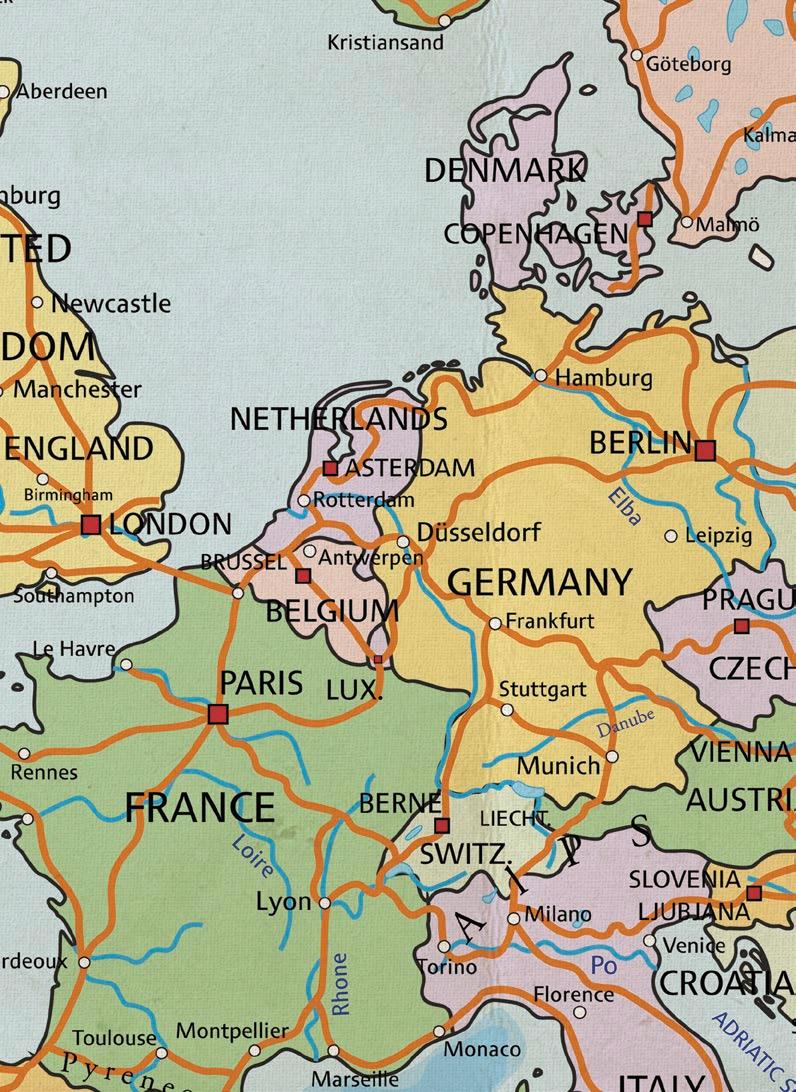

escape the heat and stench of seasick passengers crammed together below. She saw twinkling lights just 800 yards away. It was the holiday island of Lampedusa—the closest part of Italy to Libya. She had endured a perilous 18-month journey. Others gathered on deck, excited.
After 36 hours at sea, the end is in sight. Suddenly, the boat’s spluttering diesel engine stops. With the bilge pump no longer working, water begins to pour in. The captain cannot restart the engine. He pours petrol onto a blanket and lights it to signal for help from the shore but fuel also spills onto the deck, which catches fire.
People scramble in panic to one side of the boat. The overloaded vessel begins to capsize in a chilling slow roll. Some are thrown into the sea. More water floods in. Those below deck stand no chance.
Fanus cannot swim. Hundreds of arms and legs are thrashing around her in the sea, desperately trying to keep afloat. She clings to the railings of the sinking boat. “Then this man throws his arm around my neck and drags me under,” Fanus says, reliving the terror. “I push him down and, splashing my hands like a dog, I get back to the surface. Somebody pulls me back to the upturned boat.”
After four hours in the water, Fanus was rescued by the coastguard and taken ashore to hospital. Fanus was safe, but others were not so fortunate. Some 363 people, the great majority from Eritrea, drowned that day. Of the
90 women on board, only five survived. It was a catastrophe that grabbed media attention. But according to the Migrants’ Files project—a database of deaths compiled by a pan-European consortium of journalists—a further 25,000 migrants have died attempting to reach Europe since 2000, most of them drowning on unseaworthy boats that capsized or sank.
w haT led fanus T o embark on This perilous journey? She had enjoyed an idyllic childhood, growing up in a Coptic Christian family, with five brothers and one sister in a market town in the south of Eritrea near the border with Ethiopia. “Everything was beautiful. I had lots of friends. I loved school, especially singing and playing football in the school team,” she says.
Then one day in 2011, when Fanus was 15, it came to an abrupt end. Soldiers marched into her school. They had come to round up conscripts. “They took us to a prison, very big and frightening, with many kids from many schools there.”
With a population of 6.2 million, Eritrea was formed in 1993 after a bitter war of independence with Ethiopia.

But the heroes who led the fight became brutal peacetime dictators, banning elections, the constitution and jailing 10,000 political prisoners.
Since 1998 there has been compulsory, indefinite military conscription for boys and girls from the age of 17. Conditions are harsh. Girls are often raped and forced into marriage. Eritrean soldiers operate a shoot-tokill policy for those who desert.
Fanus was later freed. Slight and bright-eyed, she was too young to serve. This time. Back at school there were very few children left in the senior classrooms. Many of her friends were now in army barracks, but others— rather than face a life sentence in uniform from which they wouldn’t
Survivors of the 3 October 2013 sinking are brought ashore on Lampedusa
emerge until middle age—had chosen to flee. “That’s when I started to know that I had to leave too.”
She didn’t discuss her decision with her parents—they would have done everything to stop her. Her 17th birthday approached. It was now or never. Fanus’s eldest brother, aged 30, had already escaped to Israel. “I had no plan,” Fanus says, “just to get across the border to a children’s refugee camp in Ethiopia.”
One morning, in the spring of 2012, she left home, wearing a pair of jeans and a T-shirt, carrying nothing but her student ID card. “I knew that if I was
When you write or update your will, please remember the work of the British Red Cross. By leaving just 1% of your estate, you can make sure we’re always ready to help people in crisis, whoever and wherever they are, in the UK or abroad.
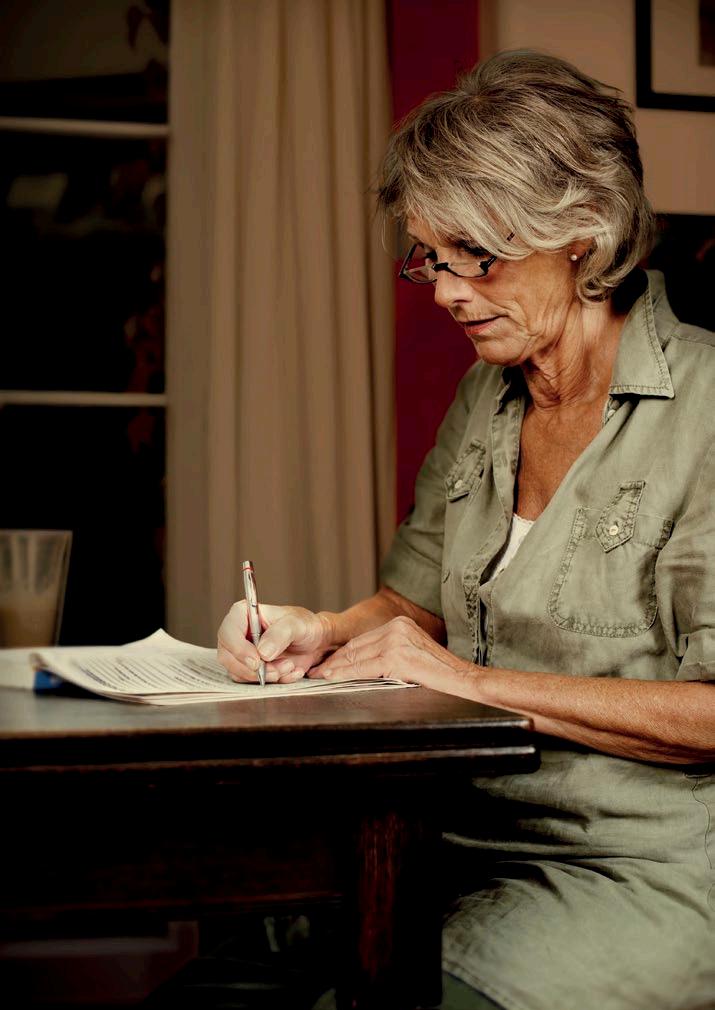

Find out more about remembering the British Red Cross in your will. Call 0800 138 4000 or visit redcross.org.uk/giftinwill today for your free information pack.

stopped as a student nothing bad would happen to me. They’d just send me home again.”
Most Eritreans aren’t able to obtain a passport or an exit visa. Around 5,000 flee the country every month. Like them, Fanus started walking. More than five hours later she was picked up on the other side of the border by Ethiopian soldiers. They took her to a refugee camp. “I thought I would be safe there.”
But Fanus had become a refugee, joining a dangerous world in which people become prey to the worst kind of criminals. Inevitably, the longedfor destination is the safety and security of Europe. The main points of entry are Italy, Greece and the Spanish enclaves of Melilla and Ceuta on the coast of Morocco. Getting there can mean taking terrible risks, but this doesn’t deter many thousands of desperate people.
FANUS wAS liviNg iN AppAlliNg
co N ditio NS in the Ethiopian refugee camp—short of water, sleeping two and three to a bed and with little to eat. Like many others, Fanus was prepared to entrust her future to the people smugglers. “I met this Eritrean who told me that he would get me into Sudan, to Khartoum, and once there I could ask my family for money to pay for my trip.”
Late one night in July 2013, she boarded a taxi. “I was driven to some woods in the middle of nowhere in
northern Ethiopia, one of just three girls among many men. They put us in the back of a Toyota Hilux pickup. They made us lie down; they put a quilt over us then put fruit on top to hide us.”
Five days later they arrived in Khartoum. “We ached badly and we were stained by the fruit—our bodies looked as if they had been painted.”
Now she had to find just under €1,900 for a Sudanese trafficker to take her on to Libya. “He gave me a mobile phone to call my brother in Israel. When I told him where I was, he was shocked and angry. ‘You are a child. It is very dangerous. I don’t want you to go through with this,’ he said.”
He relented. He wired money he had managed to save and Fanus had enough for her onward passage and a change of clothes. She was one of 131 people, including 20 women and a three-year-old child, who set off across the Sahara for Libya in trucks. The eventual destination was Tripoli, 1,680 miles away, where they hoped to find a boat to Italy.
Once in Libya they were handed over to local smugglers, but almost immediately they were kidnapped and then held hostage in the mountains for 27 days. “Every night they tried to rape the women and when our men protected us the kidnappers hanged them upside down and beat their feet.” Her eyes are downcast. Fanus doesn’t go into any further detail, but it’s well established that some Eritrean women
Live the life you want at a choice of great locations

With McCarthy & Stone you own your home, enjoying continued independence and total peace of mind. Buy one of our Retirement Living apartments and we’ll take care of all the external maintenance. So you’re free to do more of the things you enjoy.
Community and privacy – The best of both worlds with a homeowners’ lounge, landscaped gardens and your own apartment.
24 hour security – With camera entry systems and emergency call points for total peace of mind.
Onsite Managers – All our developments are run by a dedicated Manager.
Guest suites – Perfect for when friends and family come to visit.


Choose one of our Assisted Living apartments and receive the flexible levels of care and support you need to continue leading a fulfilling life. Awardwinning builders with years of experience, McCarthy & Stone can help make your move easier every step of the way.
Flexible care and support – Exclusive to our Assisted Living developments, onsite care staff 24 hours a day, and freshly prepared meals in the table service restaurant#
McCarthy & Stone has apartments for sale at over 100 developments across the UK. So wherever you want to buy, we’ll have a location to suit you.
Please call us free* on 0800 201 4314 or visit
a long way to stockholm: fanus’s jouRney


have been doused in gasoline until they submit to rape by kidnappers.
Fortunately, her brother paid a ransom of €2,600 and eventually in early September 2013 Fanus made it to Tripoli and there, in a squalid covered courtyard with 700 others, she waited and hoped for a boat. It proved to be the fateful fishing boat that capsized with the loss of 363 lives.
F ANUS w AS o N e o F 14,753
migr AN t S who got to Lampedusa alive in 2013, nearly 10,000 of them from Eritrea. She and her fellow survivors were taken to the island’s crowded migrant reception centre,
where they were clothed, fed and assessed by medical staff.
Suffering post-traumatic stress and nightmares, Fanus remained at the centre for more than three months. She had set her sights on reaching Sweden, home to around 45,000 Eritreans and where she had a relative.
Current rules say all asylum seekers must remain in—or will be returned to—the country of entry. In practice, Italy benefits from turning a blind eye to migrants determined to settle elsewhere in Europe. Fanus nonetheless feared registration and tried to burn her fingerprints off with a lit plastic bag. And after being moved
the eu is struggling with the flood of migrants on its shores
after the sinking of Fanus’s boat, the italian navy launched operation mare nostrum on october 18, 2013, to rescue those in peril. in 421 operations its 32 ships, two submarines, helicopters, drones and 900 personnel saved over 150,000 migrants and helped bring 330 smugglers to justice. unable to continue bearing the cost alone, italy closed down mare nostrum in november last year. in its place the eu
border agency Frontex introduced operation
triton. it began work with just six vessels, a helicopter and two aircraft covering the 1.5 million square miles of the mediterranean on a monthly budget of €2.9 million. the emphasis now is on border security rather than humanitarian search and rescue, which some argue encouraged migrants to attempt the crossing. rescue is now down to the italian coastguard, operating within territorial waters, and merchant ships. two weeks after mare nostrum ended, 477
asylum seekeRs in eu-28 countRies
472,395 applicants, july 1, 2013 – june 30, 2014
migrants were rescued by a panamanian tanker and taken to sicily.
cecilia malmström, european commissioner for home affairs, said that 90 per cent of asylum seekers are taken in by just ten eu countries. “several eu countries are accepting almost no one. this is a disgrace.”
of 326,310 initial decisions during 2013, 112,730 applicants (34.5%) were given asylum or leave to stay.
on the anniversary of Fanus’s ship sinking, the unhcr revealed that in the nine months to october 1 last year, 3,000 people had drowned crossing the mediterranean—four times as many as in the whole of 2013. and the unhcr predicts deaths will rise further this year without a change of heart by the eu “with support for anti-immigration parties surging across europe, that seems far off,” says meron estefanos an activist and journalist born in eritrea and raised in stockholm, who has visited lampedusa. “in spite of the risks, they keep coming.”
Helped by her brother and sympathetic Italians en route, who paid the traffickers and for her travel documents, Fanus was directed through stations and air terminals by a trafficker via mobile phone. On January 20 last year, Fanus finally made it to Stockholm airport. And for the first time in nearly two years she slept without fear.
FANUS hAS Now bee N grAN ted AS ylU m and her first official passport. She lives on state support in the city of Sundsvall, a few hours north of
Stockholm, where she goes to school and shares a flat with three other Eritrean girls. Outwardly, she’s a typical 18-year-old, playing football and hoping to become a singer. “A Swedish singer!” she laughs. Five of her siblings have also reached safety in Belgium and Israel. Fanus is surprisingly open and trusting. “Yes, I’m happy. Whatever God chooses for me, I will be.”
Then her face clouds. It is the anniversary of the sinking of the boat. “I wish there was a legal way for people to come here to claim asylum to avoid the loss of life.” And tears flow. “I can never forget. There was a woman who gave birth on the boat. She drowned with her baby.” to an immigration centre in Sicily, she escaped to embark on a lengthy journey by bus and train and plane via Rome, Milan and Barcelona.
t op signs that you’ R e officially olde R
prefer to prep your lunch for tomorrow than party? need to get home to iron your sheets? according to distractify.com, you’ve simply grown up:
if someone asks you about a restaurant or bar, the first thing you comment on is the noise level.
your meal choices moved from “what’s the cheapest?” to “what’s not going to give me heartburn?”
saturday mornings aren’t for sleeping in; they’re for car-boot sales.
you’ve excitedly recommended your favourite vitamin supplement to a friend.
you’ve fake-laughed at so many bad jokes by people you need to impress that you don’t remember what your actual laugh sounds like.
you harshly judge your friends that still live like they’re students.
you leave parties so you’re home in time to get your full eight-hours’ sleep.
Abigail’s family (below) met several of Guernsey’s donkeys on their travels
By Catherine Cole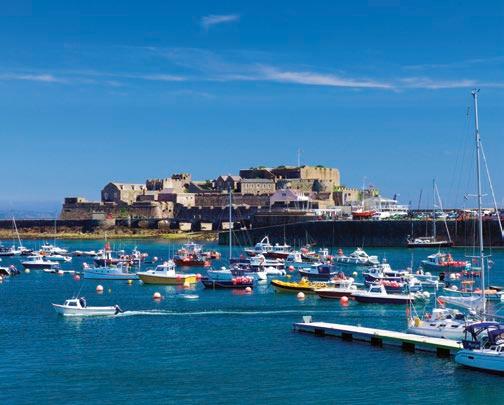
Abigail Watkins from Derby achieved a lifelong dream on a family trip to the island of Guernsey

Catherine has danced in Rio, been microlighting in South Africa and hiked the mountains of Oman
Tell us about your favourite holiday (send a photo too) and if we include it on this page we’ll pay you £50. Go to readersdigest. co.uk/contact-us

BOOM! The nOOn gun aT CasTle COrneT was so loud that we were warned to cover our ears.
I’d brought my four children to Guernsey to visit my sister. Castle Cornet used to be an island, but it’s now connected to Guernsey by the harbour breakwater. During the Second World War it was occupied by German troops, and the kids’ appetite for horrible history was fed by the fact that during a lightning strike in 1672, the Governor was thrown as far as the battlements, unharmed but still in his bed.
It’s a great place to dress up: my daughter was happy to put on a princess outfit and parade up and down the many steps, though the boys wouldn’t dress up—even as knights. During a Tudor artefact treasure hunt at the castle, we met a bride marrying in the grounds. We slipped through the champagnesipping wedding party feeling rather underdressed—except my daughter, of course! We also visited the Little Chapel, a lovely miniature building in the centre of the island that has a spire decorated with seashells and broken china.
We did some donkey spotting too. Islanders embrace the donkey as a symbol of Guernsey, and 40 fibreglass donkeys
are positioned at spots around the island. We were intrigued by the creative patterns on the five donkeys we found—the children especially liked the rainbow-striped one.
But the highlight was achieving a lifelong dream of horse-riding along Vazon Beach one morning. We had it to ourselves apart from a couple of dog walkers. It was great fun, and a good way to get another perspective on the island and to enjoy the views, the beach and the sea at a gentle pace. Of course, being able to share it with my family made it unforgettable.
■ GettinG to Guernsey
Return flights to Guernsey from London Gatwick with Auringy start from £79pp (aurigny.com; 01481 822 886).


at the crossroads between Europe and Asia, Istanbul is one of Europe’s most storied cities. Uniquely, it’s split across two continents by the glittering Bosphorus, and both the European and Asian side are very different in character. This is a city where modern (the vibrant Taksim Square and surrounding Beyoglu entertainment quarter) sits happily with old, with tiled minarets and mosques scattered down cobbled streets. A visit to former Ottoman residence Topkapi Palace is a must, as is exploring the Byzantine Hagia Sophia and stunning Blue Mosque —probably the most recognisable of all Turkish architecture.
■ inside istanBul
Corinthian Travel’s six-day Istanbul itinerary starts from £1,445pp, including accommodation, transfers, some meals and entrance fees (020 3583 6089; corinthiantravel.co.uk).

■ D O: St Patrick’s Day on March 17 is when the country lets its hair down. To celebrate the Irish patron saint, there’s a multitude of festivals, events and light shows over several days, culminating in a huge parade on the day itself (stpatricksfestival.ie).
■ sTay: The Merrion boasts a central location but is spacious, has beautiful Georgian features and is home to Ireland’s only two-Michelin-starred restaurant. Double rooms start from €275 (around £215) per night on a B&B basis (merrionhotel.com; 00 353 1 603 0600).
■ e xplOre: Trinity College is a peaceful place to explore over a morning before all the students get out of bed. The campus library is also home to the famous Book of Kells, a Latin manuscript depicting the four Gospels of the New Testament (tcd.ie; 00 353 1 896 1000).
l ong/short haul: walk I ng hol I days
shOrT : Montenegro Spring is the ideal time to explore Montenegro’s mix of shimmering seas, mountain lakes and quaint old towns. Headwater’s seven-night walking tour starts at £1,078pp, including accommodation, transfers, guide and most meals (headwater.com; 01606 827 239).
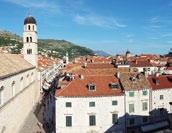
lOng: Japan Tread the ancient Nakasendo Trail and explore Tokyo with Macs Adventure. Eleven days starts from £1,595pp, including accommodation, some meals and some transfers (macsadventure. com; 0141 530 5460).

travel app of the month
roamer. Free, iOs, android. While using your mobile phone abroad isn’t as costly as it used to be, no one wants to arrive home to a huge bill. Roamer allows you to make and receive cheap calls abroad using a wi-fi connection or by linking to a local Sim card (roamerapp.com).




The Little Chapel was a work of art and a labour of love. Nestled in a picturesque valley in rural St Andrew it is a perfect stop off on one of our self-guided Tasty Walks. Continue down one of the nearby Ruettes Tranquilles, where nature is at your fingertips. Literally.
Travel & Stay: ISLAND GETAWAYS
T: +44(0) 1983 72 11 11
W: ISLANDGETAWAYS.CO.UK
Island Getaways, a leading tour operator to Guernsey. Great prices. Great service. Call now, 0198 72 11 11
islandgetaways.co.uk

Travel: AURIGNY
T: +44(0) 1481 822886 W: AURIGNY.COM
Top three in Which? Magazine’s ‘Best Airlines’ Poll. Fly London Gatwick, London Stansted, London City, Manchester, East Midlands or Bristol.
As part of a return fare. Includes taxes, bookable online. Conditions apply. T&Cs apply.


Plan your short break at

Even on an adventure cruise to Antarctica, the continent can be remote and mysterious
By Chris Jones
The National Geographic Explorer photographed during a hike up an icy slope
I bEgAn bElIEvIng In ghosts EArly onE mornIng—at what would have been dawn if Antarctica bothered with dawns—on the bridge of the National Geographic Explorer.
i was mentored in the ways of unseen things by the ship’s first mate, Piers Alvarez-Munoz, his name rivalled in its magnificence only by his beard. his radar screen was a wash of specks—ice floes and birds with 11-foot wingspans. A snow squall had blown across the drake Passage and we couldn’t see much beyond the bow of the ship.
Alvarez-Munoz checked his charts and compasses, and plotted our course with a pencil because these waters defy even the most advanced machines. Then he nodded: Antarctica was in our immediate range, even though the only instrument able to find any sign of it was his heart.
After such a long journey, it was hard to accept that we were almost there. My 140 fellow passengers had come from across the world: flights first to Buenos Aires and then to Ushuaia, a small, colourful town at the bottom of Argentina. Then we had boarded the Explorer and nosed through the shimmering Beagle Channel—to our left the mountains of Argentina, to our right the slightly more dramatic mountains of Chile. We slipped into the Drake Passage sometime around midnight. The seas grew rougher where the Atlantic and Pacific met. Nearly 40 hours after we’d pushed away from safe harbour, there stood Alvarez-Munoz, insisting that, any moment now, Antarctica would appear before us.
When it did not, he unrolled another chart to justify his belief in paranormal
landmasses. The sea, now the Southern one, was 18,000 feet deep here. But nearby, underwater peaks rose within 650 feet of the surface. No one had ever climbed or even seen these ranges, but that didn’t mean they weren’t there.
It might seem impossible that there are destinations on this planet that we haven’t visited, but in many ways Antarctica is an article of faith more than a hard physical fact.
“All the best mountains are hidden,” Alvarez-Munoz said before he turned his binoculars back to the uniform grey in front of us.
Not long after, the wall of mist and snow opened up, and on the horizon to our right was an iceberg, shaped like a triangle. Then came another, larger and to the left. Then another, the way seagulls foretell arrival at more conventional shores. At last, there was a small knob of grey rock in the distance, the first of the South Shetland Islands, the ambassadors of genuine Antarctica. It felt as though we had finally arrived. Alvarez-Munoz ran his fingers across his chart and extended his pencil line, and by the time he looked
Ninety-three per cent of the world’s mass of icebergs surround Antarctica

back up, the rock and everything that it represented had disappeared.
Months later, my memories of that trip aren’t like memories of other trips. There are no tall buildings, no roads or signs or music, no snapshots of indigenous faces, none of the time stamps given to us by day and night. There was always light, the sun setting spectacularly before changing its mind at the last moment and rising again. When I close my eyes, there are 100 shades of blue and white, snow and ice, sleeplessness and awe. I don’t remember specific locations and I can’t say I fully remember moments. I remember the goose bumps and lumps in my throat.
“Expedition Day in the Weddell
Sea!” the briefing read one afternoon. “Please listen for announcements regarding our plans, which will depend on weather and ice conditions.” The Weddell Sea is among the more daunting bodies of water on Earth, a whirlpool trapped between the Antarctic Peninsula and Cape Norvegia in Queen Maud Land that gathers ice in all its forms: tabular bergs; floes, white and sheetlike; bergy bits on their way to becoming ocean; and growlers, blue boulders floating like corks. One survey found 30,000 icebergs in 1,500 square miles. From the bow it looks like a different planet where ice is a living thing. It snaps and howls and groans; it lifts and rolls and crashes. A brave decision was made: we’d push south as far as we
could, because at the end of it there might just be Emperor penguins.
We stood on the bridge or the bow, looking out across the water. Six killer whales popped up beside us, and one dived under the ship, turning upside down to show off its undercarriage.
Then fog and snow rolled in. Icebergs loomed; the Explorer passed over a bergy bit that shuddered down the hull. Everything was silver and spooky until the storm blew out and we found open water. A sheet of ice appeared in the distance as wide as a plain, and through binoculars we could see some small dots on it. The crew let the currents draw us towards the ice. Our hull dug into it just hard enough to anchor us, and there they were: eight Emperor
penguins on their miles-long march back home, somewhere beyond our scope. Then Antarctica did what it does and they were gone.
We turned around and retreated north. Celebrating in the ship’s lounge, we felt as though we’d really arrived now, as though we’d finally completed each of our private unspoken quests. The Explorer’s passengers were mostly older, and many of them possessed that particular brand of gratitude that comes with time and travel. I don’t think I was the only one who had trouble holding it together.
We had come all this way and cashed in so much good fortune for the outside chance that we might see Emperor penguins. And we did. In a world that




can seem engineered for our safety and convenience, every part of that longshot day felt as fleeting as luck itself. That feeling is what I remember, and that’s why Antarctica remains impervious to memories. All of its settlements are temporary. Its borders migrate. Its landmarks are seasonal.
throughout six days in Antarctica, each one gorgeous and spectacular, that feeling of impermanence became almost sinister. At first it crept up in odd ways: penguin eggs cracked open by predators; killer whales prospecting for seals; bleached whale bones on a beach. We could fool ourselves that we were invulnerable, given our comforts, our bowls of ice cream and our hot chocolates spiked with whisky, and we could sleep soundly knowing that the right eyes watched over us. But there
remained constant reminders that we were in parts that didn’t welcome us as warmly as our waiters did.
It happened to me twice. The first time was inside Orne Harbour, a tight crescent ringed by mountains and glaciers. We took an inflatable boat to shore and climbed through the snow to the top of a ridge. It was a perfect day, skies as blue as the water, the sun shining, warm enough to strip off our jackets and sweaters. The ridge gave us a view across more mountains and glaciers through air so clean I could feel my lungs turning pink again.
We hiked and backside-tobogganed down some slopes, laughing and taking pictures. Some chinstrap penguins stared at us. It was a magical few hours, and I joked with one of our guides that I wouldn’t be getting back on the ship. He wished me luck and smiled, but the

e: info@gibraltar.gov.uk
t: +44 (0) 207 836 0777
@visit_gibraltar
facebook.com/visitgibraltar

way he said it had an edge to it. He knew I wouldn’t stand a chance.
So I’m not sure why I did maybe the stupidest best thing I’ve done. We were at Port Lockroy, an old British research station that’s now a museum. It was time for a polar dip. Those passengers who dared could strip down to their shorts and drop into some of the coldest water on Earth. The guides asked if anyone thought they could stand that water for more than a minute. Four of us said yes. We were younger and stupider than anyone else on board.
Our vital signs would be monitored. I decided to wear a snorkelling mask, because I harboured some delusion that I’d have the physical wherewithal to sightsee. We trembled our way out of the ship, our bare feet curved around the makeshift diving platform—and then we jumped.
It was a very long minute. Within seconds, my legs and arms went numb. My breathing became shallow and my heart began to claw out of my chest like a cat from a bag. Nearly every drop of my blood rushed to my core, my body now its own lifeboat: organs and circulatory system first. I remembered to put my face into the water. Between my paralysed feet, all I could see was a bottomless down. After more than a week without darkness, that water reminded me what night looked like, and it both thrilled and scared me.
Finally the minute was up. We clambered out and tied ourselves in knots trying to warm up. Our bodies were
crimson. We said some very bad things a little too loudly, and I went straight to the dining room, ravenous, and ate about 7,000 slices of pizza.
Slowly the feeling came back to my digits, except for the middle finger of my right hand. All these months later, it still has a small circle of numbness at the tip. It’s become my reminder of a trip that I can’t really remember but for so many reasons want never to forget.
The guides asked if anyone ThoughT They could sTand ThaT waTer for more Than a minuTe. four of us said yes
the iCe was partiCularly widespread last winter; it had snowedin five staff from Palmer Station, the small US research outpost, for several months beyond their scheduled finish. Word had come that they would really like a lift home.
To get to them, we cruised through the Gerlache Strait and the Neumayer Channel. The powder steam of avalanches rose off the mountains around us and the ice crackled like power lines. We turned down the Bismarck Strait, leaving a trail of open water in our wake that would soon disappear. Bergy bits thudded against our hull.
FREE Guide to selling your Timeshare
Timeshare specialists for resorts worldwide
Fully compliant with EU legislation
Floating weeks, xed weeks, points & club memberships
No sales commission or upfront sales fees
“Our family are all grown up now”

“We want to go on cruises”


Readers of Reader’s Digest can receive a £50 voucher redeemable at over 120 high street stores including John Lewis & Waterstones*
FOR YOUR FREE 16 PAGE COLOUR BROCHURE CALL
0800
012
4676
Services o ered include timeshare resales, client purchases, trade-ins, legal disposals, alternative holiday products as well as o ering advice on getting the most from your existing timeshare ownership.

And then Palmer Station came into view, a collection of blue metal-sided buildings, oil barrels and shipping containers perched on grey rock.
The bridge and the bow were packed with spectators, and maybe 40 station residents were standing along the shore, cheering back at us. We saw a man, tall with long hair, pumping his fists. He was one of the five overdue, and now we could pick out the others just from their joy.
The Palmerites—scientists and support staff—were ferried across. Watching them board, I thought they must have been feeling as though they were leaving the moon. In truth, they felt as though they had landed on it. The tall man pumping his fists had spent seven months at the station. He went straight to the ship’s bar, and the look on his face when he took his first sip of beer made us want to know what he knew. A crush of passengers surrounded him and the others. They looked almost alarmed by their peculiar celebrity. In
their months away, they had become shadows of their former selves. They had forgotten the sensation of endless hot showers and the smell of oranges, but they had also forgotten how to survive among the living.
When we returned to the Beagle Channel, the Palmer Station Five stood at the top of the ship. They looked at Ushuaia the way we had looked at the South Shetland Islands all those days earlier, before we had learned to believe. Spend enough time in Antarctica and it’s no longer a spectre. It becomes real, and the rest of the world, the rest of us, become the ghosts. For the first time in months, those five men and women saw grass. They saw trees with leaves in them. They saw cars and they saw colours. A plane took off from the airport and the tall man shook his head. “I kind of forgot we could do that,” he said, laughing.
All the best mountains are hidden. All the best mountains are right in front of our eyes.
C an you explain the 1990s in four words?
thousands took to twitter to sum up the decade:
Don’t go chasin’ waterfalls @hindsightvh1
Phones can only call @cmclymer
Can’t find my pager @tylermorrison1
baby, one more time @jodymarissa
smelly cat, smelly cat @GrooveMadonna smells like teen spirit @thehellbillycat
A new financial year can bring a fresh start, while the end of the previous year is a chance to tie up loose ends

Nick Hill is a money expert at the Money Advice Service. Visit money adviceservice. org.uk for details

The amount you can pay into your new individual savings account (NISA) each year was increased to £15,000 last summer, and you have until April 5 to pay in as much as you can up to that limit. Once the new tax year starts on April 6, you can either put money into an existing NISA or open a new one—this time with an annual allowance of £15,240.
Keep an eye on the interest rates of any ISAs from previous years too. If rates have dropped or bonuses ended, you can often move your money to better paying accounts. Just remember to ask your bank to transfer the money for you rather than withdrawing it yourself to make sure you don’t eat into the new tax year’s allowance.
Give gifts to protect your inheritance
If you think your estate might have to pay inheritance tax, there are some simple things to consider doing to help reduce it.
A combination of errors by Roman priests after Caesar died and the English Protestants’ refusal to follow Rome and switch in the 16th century, meant calendars in the UK were out of sync with the rest of Europe. By 1752, many celebrated the New Year and paid their taxes on March 25. To keep it a full tax year and not lose income, the financial year was moved to April 5. The extra “leap” day added in 1800 moved it to April 6, where it has stayed.

Normally, any money you give to other people in the seven years before you die is subject to inheritance tax, but each financial year you can give away up to £3,000 and it’s exempt. If you didn’t do this the previous year, you can carry it forward for one tax year. In addition, you can gift up to £250 to as many people as you want per tax year and, again, your estate wouldn’t have to pay inheritance tax on any of these.
When you sell certain assets, such as a second property, shares, jewellery or piece of art, you usually have to pay capital gains tax on any profits. Each tax year you get an allowance of £11,000 in profits before the tax is due. Some things are exempt, such as cars, and there are other exclusions such as a £6,000 cap on some personal items. It’s charged at two rates, 18% or 28%, depending on whether you’re a basic or higher-rate income-tax payer.
If you’re planning to sell some valuable assets soon, see if you can take advantage of the £11,000 profits threshold for this financial year. Then from April 6, you’ll have a fresh allowance before any tax is due if you sell again.
There’s a new licence-plate release on March 1, so many people will be off to the forecourt to look for a new motor. But buying a brand new car won’t just be one of your most expensive purchases—it could also be one of your biggest losses.
As soon as you drive a car out of a showroom, the sell-on price drops hugely. This is called depreciation, and it can be as much as 35% in the first year and 50% after three.
You might be better off getting a nearly new or used car as you won’t lose the first big chunk. You can find a car-costs calculator at moneyadviceservice.org.uk to help you compare different prices and running costs.
Whether buying new or second hand, consider the following factors that can depreciate some cars more quickly than others.
■ MilEagE: The more miles, the less your car is worth.

■ rEliaBilitY: Some cars have a poor reputation for this.
■ NuMBEr Of OWNErs: The fewer the better.
■ gENEral cONditiON: Damage to the bodywork, interior and exterior will reduce value.
■ sErvicE histOrY: The more complete the better.
■ lENgth Of WarraNtY: Some manufacturers now offer as long as seven years, which is a bonus when selling your car.
■ dEsiraBilitY: The more recent the model, the better it will hold its value.
■ sizE: Big luxury cars tend to depreciate more than smaller cars.
■ fuEl EcONOMY: The more miles per gallon the better for many buyers.
When your insurance is due for renewal make sure you shop around to find the best deal. QuickPages has brought together some of the biggest Insurance brands to make it easy for you to ring round and get the best quote!


















UK pension rules are currently quite restrictive. You can either buy an annuity with your private or workplace pension pot, or “drawdown” cash as you need it. That’s about it. But April brings with it some big changes as the rules for accessing your pension are relaxed.
From April 6 this year, as long as you’re over 55 years old, you’ll have much more choice about how you use your pension to fund your retirement. You’ll be able to:
■ Take up to 25% of your pension pot tax-free and convert some or all of the rest into a taxable annuity.
■ Take up to 25% of your pension pot tax-free and take some or all of the rest as a lump sum, which will be taxed as if it were income.
■ Withdraw your cash in stages, with 25% of each withdrawal taxfree and the remaining 75% taxed as if it were income.

You can still continue to save into your pension and benefit from tax relief, even after you have started withdrawing your cash. From April 2015, you’ll also be offered free and impartial guidance on your options by phone or face to face.
the 55% “death tax” on pension funds ends on April 5. If you die before you reach 75 with some of your pension fund still invested, it will pass on tax-free to whoever you’ve named.
If you’re over 75, the beneficiaries will be able to take any money from the fund themselves or take it as a lump sum—although until April 2016 it will be taxed at a flat rate of 45%.
Easy-to-prepare meals and accompanying drinks

Rachel is a food writer and blogs at thefoodieat.org
PeoPle often think of mussels in terms of France’s classic dish, moules-frites. But mussels have been cultivated in British waters for hundreds of years— seven million tons of them are farmed in Scotland alone. So it makes sense to showcase them alongside some more of Britain’s best produce: cider, bacon, sage and English mustard. What delights!
Britain’s mussel season comes to an end around the start of April, making them a wonderful early-spring dish, perfect for quick and cheap midweek suppers.
Serves 2 as a main course, 4 as a starter
• A knob of butter
• 6 rashers of smoked back bacon, chopped
• 1kg mussels
• 180ml dry cider
• 1tsp English mustard
• 2tbsp of buttermilk or cream
• Salt
• Freshly ground pepper
• 4–6 sage leaves, finely sliced
• Sliced bread (cottage loaf or soda bread, to keep with the British theme!)
1. Before starting, scrupulously check the mussels. Chuck any with damaged or broken shells. If any of the shells are open, then gently tap the mussel on a hard surface—if the shell doesn’t quickly close, then discard.
2. Put the mussels in a big colander under a stream of water from the

cold tap, and give the shells a good scrub with a potato brush or scourer. Remove any of the fibrous “beards”.
3. Heat the butter in a stock pot or large pan until it starts to foam. Add the bacon and cook until the fat starts to turn crispy.
4. Add the mussels to the pan and pour the cider on top. Put on the lid and cook for five minutes, giving the pan an occasional rough shake. After five minutes, the shells should be open, revealing plump orange nuggets of meat inside the shells.
5. Use a slotted spoon to divide the mussels between two or four pre-warmed bowls (depending on
whether it’s a starter or main course). Add the buttermilk or cream and English mustard to the juices in the pan and season with salt and pepper to taste.
6. Ladle the sauce over the mussels and garnish with sliced sage. Serve with slices of bread to mop up the delicious juices.
The Egyptian King Tutankhamun and many Roman emperors owned “sea-silk” cloaks, which were made from thread spun from mussel “beards”.
A recently-converted cider drinker will expect something very different to an old-school scrumpy drinker. The modern way is to pile ice into a glass and fill it with a light, fizzy cider. A scrumpy is a different beast though: room temperature, flat and ferociously alcoholic.
Scrumpy got a bad reputation by being associated with rough home-brews, but there are a lot of tasty and nuanced varieties available on the market, and it makes the perfect pairing with British mussels and bacon.


Old Rosie is a great place to start. It has an excitingly cloudy consistency and is a medium-dry option with deep earthy notes. Black Rat and Jack Ratt are two more great scrumpies, which will have you playing The Wurzels while raising a glass to the West Country.
■ Old Rosie Cloudy Scrumpy Cider, westons (7.3%), £1.99/500ml

■ Vintage Cider, sandford orchards devon scrumpy (7%), £56/20 litres (great for a party!)
■ Jack Ratt Scrumpy Cider, lyme Bay winery (5.6%), £4.25/litre
and just to add an extRa kick…
if you’re not scared of a bit of heat, then try a strong English mustard. daylesford’s natural Strong English mustard is admirably fiery. Wilkin & Sons ltd and tracklements also make excellent strong English varieties.
■ Daylesford Natural Strong English Mustard, £2.59/170g
■ Wilkin & Sons Ltd Organic Hot English Mustard, £2.09/185g
■ Tracklements Strong English Mustard, £2.20/140g




Blush-pink rhubarb is a lovely reminder that spring is in full swing, although surprisingly it wasn’t until the 19th century that Brits really started cooking with it. In 1824, strawberry producer Joseph Myatt persuaded people that if bitter rhubarb stalks were combined with something sweet (like strawberries!) then it was delicious. This recipe is great when mixed with yogurt and granola, or stirred into porridge. Alternatively, try serving it with vanilla or stem-ginger ice cream.
• 400g rhubarb
• 4tbsp runny honey
• Optional: cinnamon stick, star anise, grated root ginger, strips of orange zest.
1. Preheat the oven to 180C
2. Wash the rhubarb, trim the ends and cut into 4cm batons. Put these into a shallow dish, drizzle over the honey and add your choice of spices.
3. Cover with foil and bake for 20 minutes, until the rhubarb is tender but still holding its shape.
4. Remove spices and store in the fridge.



The Great Food Collection (20 books), £9.99, The Book People. Some of the best food writing across history.

Free lecture: At sea: A Portrait of a scottish fishing community, National Maritime Museum, London, March 14 & 25. Learn about the role women played in these communities. No booking required.

mussel eaters, set of two, £29.95, John Lewis.

Home and interiors expert
Alison Cork runs luxury furniture and accessories brands alison athome.com and homeware clearance site oneregentplace. co.uk
Alison answers your questions on decluttering and spring cleaning.
QMy garage is a complete shambles! How do I go about clearing out and making room for storage?
aWhat begins as an empty space to park our cars quickly turns into a world of junk, old memories and things we didn’t even realise we owned. Begin with calling in the troops for assistance (friends, your partner or the children), hiring a waste container and investing in a shelving unit with plastic boxes.
Remove every single box from your garage and sort them into piles of what you need to keep (such as old photographs) and throw out anything you haven’t used in two years (trust me, you won’t miss it). Once you’ve figured out what needs to stay, sort items into the plastic boxes and label accordingly.
Spring is on our doorstep, which means it’s time to head outside and get to work on sowing seed, cutting winter shrubs and cleaning up your garden.
■ Take advantage of dry days and mow your lawn.
■ Prune winter shrubs that have finished flowering.
■ Sow summer bedding plants and a variety of herbs, such as chives, coriander, dill and parsley.


QI want to give my home a facelift, but don’t know where to begin. How do I start the springcleaning process?
aThe idea of spring cleaning can seem daunting at first. But by making a thorough list and slowly ticking it off, you’ll find the impossible can be accomplished. Firstly, remove all bulky items you need to clean under (not to mention smaller things from cupboards, drawers and shelves). Then give your carpets a deep clean, wash walls, cabinets and woodwork, dust lighting fixtures and take down curtains for dry cleaning. Once these bigger jobs are done, you can dust and wipe down other surfaces before moving furniture and other items back into the room.
Follow these tips to get your home clear of clutter and ready for future projects.
Conquer clutter
From old clothes and boxes to beyond-expired refrigerator items, homes are often filled with things we simply don’t need or use. target one room at a time and be ruthless—think of it as simply making room for newer and better things.
rethink your storage spaces
Utility rooms and blank walls are Diy storage projects waiting to happen. Whether you invest in clever shelving or go creative with decorative suitcases and baskets, the options are endless. Metal Trunks, £89, idyllhome.co.uk

out with the old Clearing out and cleaning up gives us a chance to really examine the look of every room. if a couch is looking worse for wear, look into having it recovered or, if a cabinet is tired and worn, sand, repaint and distress for a new and improved vintageinspired look.

Begin spring cleaning by organising your entrance way with stylish storage units and practical, chic accessories
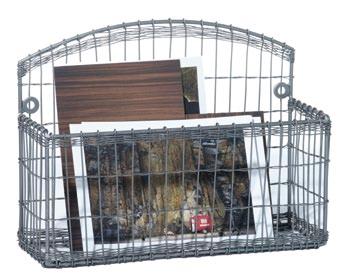


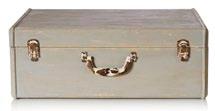


1. Wire Wall Shelf Unit, £11.99, driftliving.co.uk
2. Rabanna Small Square Red Cushion, from £70, fermoie.com
3. Small Grey Decorative Storage Suitcase, £40, oliverbonas.com
4. Grey Storage Baskets by House Doctor, £34, atnumber67.co.uk
5. Baltimore Brass and Wooden 5 Hook Hanger, £47, artisanti.com












Schrijver Damp Control’s award-winning system works via a series of elements xed into the exterior walls, designed to lower humidity levels and channel any internal moisture away from your home. Easy to install without the need for re-plastering, the system will help control any mouldy, damp-stained patches on your walls.
■ Readers receive 10 per cent off all orders installed before March 31, 2015*. Visit schrijverdampcontrol.co.uk or call 01689 800 101 and quote RD10. *T&Cs apply.
Treat your kitchen to a new look and bene t from a 30 per cent discount on all orders from Kitchen Magic. e company will replace your kitchen doors, drawer fronts and worktops and can update your space without invasive and costly renovation. Choose from over 400 colours and styles, as well as a large range of sinks, taps and kitchen appliances.
■ For a free brochure or no obligation quotation, call 0800 169 4748 or visit kitchen-magic.com and use code RD/ BH/03/15 before May 1, 2015.



The latest gadgets from the International Consumer Electronics Show in Las Vegas
By olly mann
Olly is a technology expert, LBC presenter and Answer Me This! podcaster
It’s now standard for mobile phones to come equipped with all sorts of gadgets— yet somehow the major manufacturers haven’t come close to matching the battery life of your old Nokia 3210. Storedot might be about to change all that. They’ve created a way of reviving a phone battery from 5% to full capacity in just two minutes. Currently the process requires their own-brand batteries and docks, but surely it’s only a matter of time before they sell the technology into the next generation of phones.

KwiKSet Kevo
Humble door-lock technology has remained unchanged for centuries, partly because homeowners worry that digital solutions are more fallible.

With this new system from Kevo, your front door unlocks automatically when it senses the phone in your pocket. Cleverly, you can to permit temporary access to anyone with the app.
This year’s show featured an onslaught of pointless wearable tech, from the smart belt that loosens up when you sit down, to the smart T-shirt that tracks your location. Mostly, these can be discounted as headline-grabbing gimmicks, unlikely to ever make it to the shelves of major retailers. But TempTraq is a genuinely clever concept: a smart thermometer for babies that sticks to their skin like a plaster, constantly tracking their temperature without disturbing them. A weight off the mind for mums and dads of poorly children.

A washing machine that simultaneously handles two different loads at once? It’s the kind of concept that gets laughed out of the room on Dragons’ Den, yet with LG’s engineering and marketing prowess it’s become a real product. There’s a little drawer for delicates sitting under the front-loading washer, so you needn’t wait until you’ve filled up a laundry hamper with your smalls before chucking them into the wash. But it’s quite a large appliance, designed for American-style utility rooms— I’d be surprised if we see it on sale in Britain.

When it comes to skateboards and rollerskates, a basic level of co-ordination (which, as a child, I tragically never possessed) is required to progress from clinging to the sides at the rollerdisco. Well, the pre-teens of tomorrow will have it easy, if the IO Hawk is anything to go by: it’s a self-balancing motorised wheelie thing, which you power by leaning forward or sideways. It travels at up to 6mph and comes with lights. I bet I’d still find a way of falling off it, though.


Georgina is a fashion and beauty editor for numerous travel titles and a blogger at cargocollective. com/withgeorgia
enTrepreneur DeborAh Me ADen, star of BBC’s Dragons’ Den, and textiles expert Douglas Cordeaux bought a Somerset wool-manufacturing company in 2009, with a view to returning this once-thriving business to its former glory. In doing so, they acquired a wellpreserved piece of British craft history.
The Fox Brothers wool mill (right) was founded in 1772, when Somerset was a hub for the wool industry. As the inventors of fine flannel and a serge drape material known as khaki (which replaced the British army’s “red coat” uniform), the Fox Brothers’ impact on the textile industry has been remarkable.
The denim jacket is perfect to throw over a summery dress. Here’s how to wear this spring’s fabric staple.
1. This minimal dress from Toast looks striking with statement jewellery (£125; toa.st).
2. This denim-look cotton-blend smock from Anna Sui is as pretty as it’s soft (£330; net-a-porter.com).
3. Jigsaw’s collarless denim jacket is feminine but with an edge (£85; jigsaw.com).



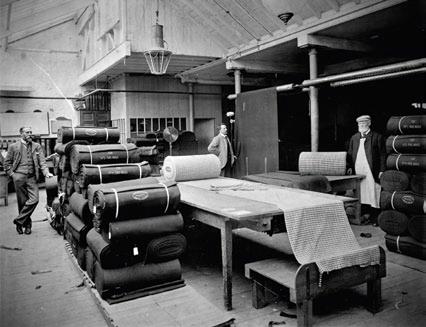
Meeting Douglas Cordeaux, I immediately notice his beautiful suit: “This is one of our most famous materials, the West of England Flannel—a favourite of Sir Winston Churchill,” he says with a smile.
The mill is now fully functioning and produces some of the finest wool cloths on the market.
Douglas and Deborah hope that soon the local community will benefit from the reboot: “We want to get young farmers interested in wool production. Shearing sheep is expensive and the fleece is considered a waste product. But there are sheep that are good for fleece and for meat—in this way we could help double their income.”
To complement the mill’s renewal, Douglas has introduced sister company The Merchant Fox, which specialises in luxury goods. It showcases some of the mill’s materials, offering customers the chance to buy a little piece of history.
■ Visit the foxflannel. com / themerchantfox. co.uk for details
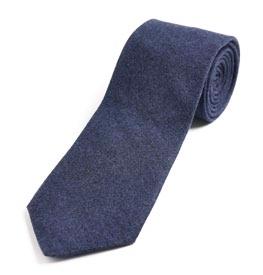
Wipe away wrinkles and blemishes with an ancient Eastern beauty remedy used by Chinese princesses and Japanese geishas for centuries. Silkworm cocoons are bursting with healing properties, and when dampened they release sericin, a protein that’s often found in anti-ageing creams. To use, place a cocoon on your finger, wet it with warm water and massage on your face. I recommend holistic silk’s silk Beauty Cocoons (£25; holisticsilk. com). I really love how their texture gently exfoliates the skin.

JewellerS hAve Their fileS, potters have their clay cutters—and make-up artists have their brushes. I recently attended a make-up artistry tutorial hosted by top make-up artist Barrie Griffith (below), whose clients include Naomi Campbell and Rosamund Pike.
“Make-up brushes are essential,” he affirms. “You wouldn’t be able to create a smoky-eye effect or a strong lip without brushes. They’re a key tool.”

I’ve been through a number of brush kits, but my favourite has to be from Nanshy, a brand introduced to me by Barrie: “I love Nanshy brushes. They’re vegan, meaning they’re animal friendly.
They’re extremely easy to clean with a little shampoo. And thirdly, they are so soft on the skin my clients are always commenting on them.”
If you’re looking to upgrade your tired brushes, Collection (£49.95; nanshy.com) is a great set to start with.
■ Visit lilykamper.com for details




“It includes some of my favourite brushes,” says Barrie. “I always use the stippling brush for a lighter foundation effect. I also love the crease and contouring brushes.”
These utensils certainly don’t complicate my beauty regime—in fact, they make my mornings much easier. After all, the golden rule of DIY is: get the right tools.
■ Visit nanshy.com and barriegriffith.com for details
Jeweller lily Kamper transforms the way we perceive Perspex and resin by using these commonplace materials to create extraordinary pieces. Combining contrasting influences, lily’s aesthetic is at once art deco, futuristic and industrial. lily’s latest collection harks back to the art-deco era, using a soft palette of pastels accented with marble-effect columns in royal blue and green. as well as eye-catching, her jewellery is incredibly tactile, making it a delight to wear.

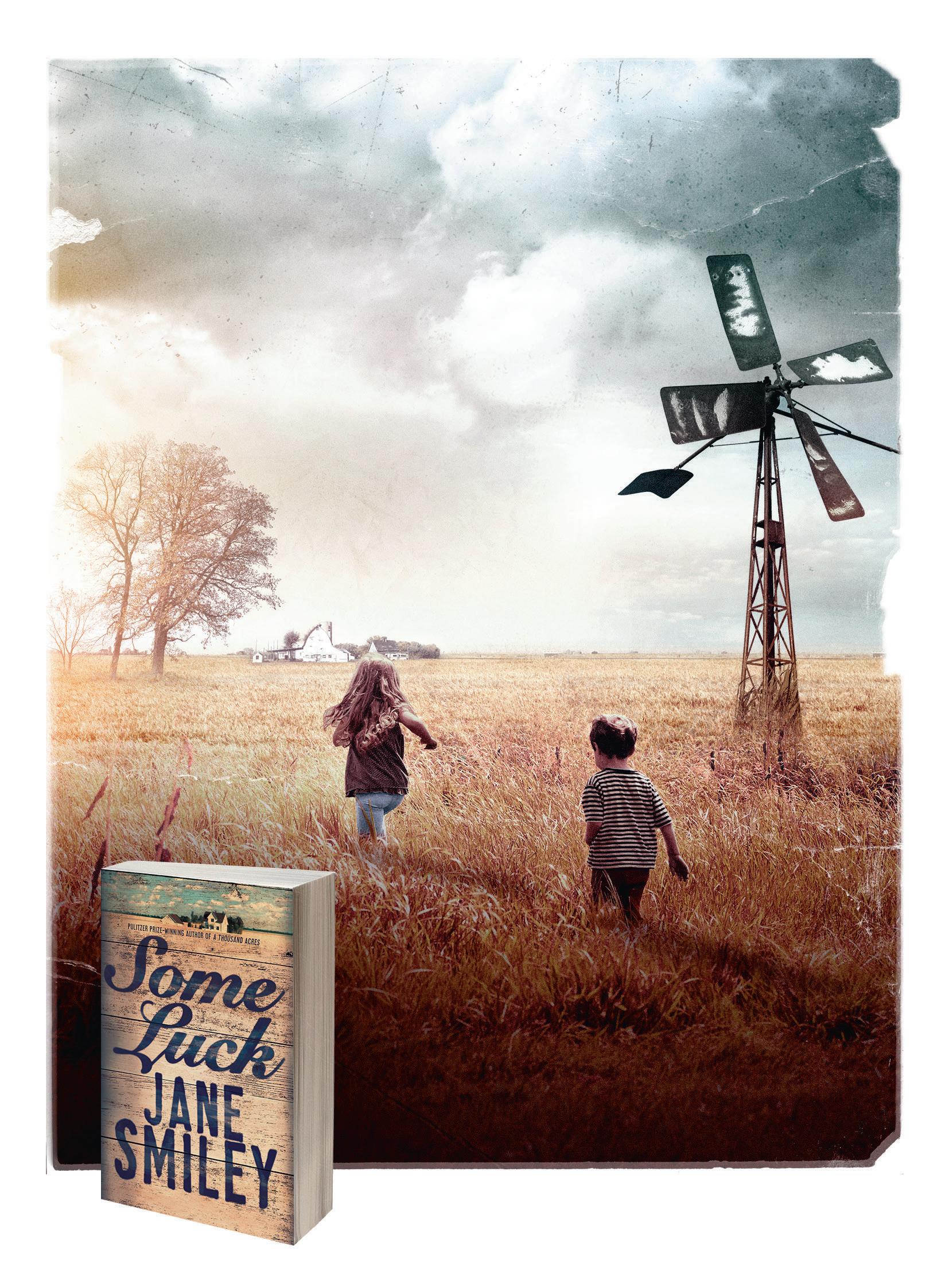
The reflections of a sharp sixtysomething, and a flawed slice of pastiche and playfulness

James writes and presents the BBC Radio
4 literary quiz
The Write Stuff
Yes! I Can Manage, Thank You! by Virginia Ironside (Quercus, £16.99; ebook, £10.99)
For the past few years, Virginia Ironside has been touring a one-woman show called Growing Old Disgracefully. At the same time, her fictional heroine Marie Sharp has been growing old rather well. This, the third bulletin from her sixtysomething life, does include a tribute to the pleasures of drinking alone —and, as ever, Marie remembers her druggy 1960s past with obvious affection. At one point, she takes in a male lodger and realises that, just like her late mother, “I’m one of those girls who do perk up a bit when there’s a man around.” Her many asides about the things that annoy her provide an entertaining reminder that in her other life as an agony aunt Ironside has always tended to the bracing. Even so, this is at heart an engagingly warm book, as Marie faces her various social, technological and medical challenges with the aid of old friends and her own essential decency. She’s also extremely good on the joys of being a grandmother.
NAME THE AUTHoR
(Answer on p128)
Can you guess the writer from these clues (and, of course, the fewer you need the better)?
1. Despite being British, she
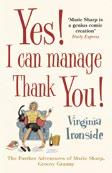
was played by Renée Zellweger in a 2006 biopic.
2. Her former home, Hill Top farm, is open to the public.
3. The main character in her first book lived “underneath the root of a very big fir tree”.

by Malcolm Pryce (Bloomsbury, £16.99; ebook, £10.99)
Malcolm Pryce made his name with a series of novels usually described as “Welsh noir”. With titles such as Aberystwyth Mon Amour and The Day Aberystwyth Stood Still, these manage the trick of setting a classic Raymond Chandlerstyle yarn in the mean streets of west Wales—and of being both brilliant pastiches of hard-boiled thrillers and genuine hard-boiled thrillers. Sadly, now that he’s tried something similar with a Boy’s Own adventure story, the results are more mixed.
The narrator Jack Wenlock is still a detective, but one who works for the Great Western Railway in 1947 on the eve of nationalisation, something he regards with horror. The plot can’t be accused of lacking invention—it contains the disappearance of a group of nuns, an African cannibal chief, the discovery of the Garden of Eden and much else besides. The trouble is that instead of combining pastiche and straight storytelling as he has in the past, Pryce here shuttles awkwardly between them.
There are still plenty of moments to enjoy, particularly in the love story between the timid Jack and a pretty client. Nonetheless, if you want to see Pryce at his considerable best, you’d be better off heading to Aberystwyth.
■ Looking for the Toffees: In Search of the Heroes of Everton by brian Viner (simon & schuster, £8.99). Viner tracks down his idols from the 1997/78 season, and uncovers the huge contrast between footballers’ lives now and then.
■ I Can’t Begin to Tell You by Elizabeth buchan (Michael Joseph, £7.99). Big, actionpacked and highly-acclaimed novel set in Occupied Denmark from the best-selling author.
■ Rock Stars Stole My Life! by Mark Ellen (coronet, £8.99). The longstanding journalist and broadcaster looks back on his career, with anecdotes aplenty.
■ Frog Music by Emma Donoghue (picador, £7.99). After the success of The Room, Donoghue heads to 19thcentury San Francisco for a very different tale of city bustle and intrigue.
■ Walking Home by clare balding (penguin, £7.99). Balding’s love for the British countryside shines out in this celebration of her experiences as a rambler.

in an astonishing new memoir, a former civil servant describes the rare condition that forces her to avoid light of any kind RD’s REcoMMENDED READ
In AprIl 2005, life seemed to be going pretty well for Anna Lyndsey (not her real name). She had a good job, as a civil servant and policy expert at the Department of Work and Pensions. She’d just bought her first London flat. She’d been with her boyfriend Pete for two years.
But then, as she was writing some briefing notes for whoever would be the new minister after the forthcoming general election, she noticed something horrifying: whenever she sat in front of a computer screen, the skin on her face would start burning “like the worst kind of sunburn”. Over the next couple of months, the condition grew ever more painful. Not only that, but it could now be triggered by fluorescent lights— and eventually by light of any kind,

Girl in the Dark
by Anna Lyndsey is published by Bloomsbury Circus at £16.99; ebook, £14.99

including that from the sun. (The technical term is photosensitive seborrhoeic dermatitis.) It also affected her whole body. Forced to leave her job, Anna moved into Pete’s house in Hampshire.
When the condition is at its worst —which can be for months at a time—Anna has no choice but to live in a completely blacked-out room, unable to see so much as her own hands, as she listens to a rather
arbitrary selection of any audiobooks she can find. (To her surprise, she’s even got to like tales of the SAS.)
Now and again, her allergy goes into remission, meaning that she can risk say, the odd twilight walk. But, in a way, this only makes it crueller when the condition returns in full force, and she takes to what she calls her “lair” once again.
Anna writes about all of this with ferocious honesty: never playing down the level of despair that can overcome her at the thought of the life that has gone—and of the life that lies ahead. Yet, she also captures the moments of beauty in those twilight walks, and the consolation to be found from friends and above all from the astonishingly supportive Pete. She can even, as in this passage, be grimly funny…
Some people believe that illness is a metaphor for the condition of the psyche. In their eyes, a problem in the back indicates an inability to put the past behind; a failure to process old emotion manifests in constricted bowels. It is my misfortune to have a condition which is peculiarly susceptible to metaphor. I prove irresistible to those of a vaguely New Agey turn of mind; they become tremendously excited when they hear about me. Here is something they have not come across before, surely a metaphorical manifestation par
RD EXclUsiVE: ANNA lyNDsEy’s FAVoURiTE AUDiobooks
English Passengers by Matthew Kneale (readers: ron Keith et al) In 1857, a long-suffering captain transports an expedition to Tasmania. Narrated by the characters in turn, it illuminated a period of history unknown to me. And there’s a wombat in it.
Cloud Atlas by David Mitchell
(readers: Garrick Hagon et al)
Six self-contained stories set in different conflict-riven societies, featuring different incarnations of one soul.
Villette by Charlotte Bronte
(reader: Carole Boyd) A young woman alone in the world goes to Brussels to be a schoolteacher. Contains the most understatedly awful ending.
Gormenghast by Mervyn peake
(reader: Edmund Dehn) A vast sprawling castle-world, with vivid denizens, ancient rituals— and the rise of Steerpike.
The Diving Bell and the Butterfly by Jean-Dominique Bauby
(reader: richard Derrington)
“Locked-in” after a stroke, Bauby wrote this by blinking at the right letter as another read the alphabet, sending dispatches from an extreme frontier.
‘Open to people’s gaze, lots of eyes looking at you.’
‘What I feel is, I’d better get out of this light before I have a painful skin reaction,’ I say, ‘which,
A reiki healer comes to see me, recommended by a friend. It is pleasant and relaxing, until the metaphors kick in
excellence. To cut oneself off from society, to insist on living in the dark in a sealed-up room—it is almost too perfect. Clearly I am terrified of human contact, indeed, afraid of life itself, desiring subconsciously to reverse the event of my own birth, and retreat to the dark close quarters of the womb.
What a fascinatingly damaged psyche! What I must do is work on myself (somehow, in the dark, on my own) and address my outstanding emotional issues (if I could work out what these were, apart from a frustrated desire to get out of the dark).
A reiki healer comes to see me, recommended by a friend. I lie on my bed and the healer moves her hands over me. It is pleasant and relaxing, until the metaphors kick in.
‘I wonder,’ says the healer, ‘when you’re in the light, do you feel…exposed?’
‘Exposed?’

AND THE NAME oF
THE AUTH o R is… Beatrix Potter (That 2006 film was Miss Potter — and that main character, Peter Rabbit.)
given my experience, is a pretty rational response.’
More work is done on my chakras. I drift into a dreamy meditative state.
‘And your partner,’ says the healer. ‘I suppose he has to do a lot of caring for you.’
‘Yes he does.’
‘And how is he about that?’
‘He’s great. I think he’s amazing.’
‘I’m wondering whether, perhaps, somewhere in your mind, you’ve got the idea that “this relationship only works if I’m ill”?’
‘I don’t think so,’ I reply wearily. ‘We generally had a much nicer time when I wasn’t.’
The healing session continues, and I relax once more.
‘Well, there’s always a benefit, isn’t there,’ says the healer, ‘even when it’s really hard to see it.’
‘A benefit?’
‘A benefit to having an illness. The deep reason why we keep having it.’
I want to leap from the bed, put my SAS training into practice and smash the woman in the face.
that changed my life

anthony browne is an award-winning children’s author and illustrator. his editions of Frida and Bear and Alice’s Adventures in Wonderland are out now. anthony is curating the big write festival in stratford this month.
I remember borrowing my cousins’ copy of this and being drawn into the story because of the mysterious and scary illustrations by N C Wyeth. They were so powerful and beautiful; the dramatic tableaux spoke to my eight-year-old curiosity. I’d always liked reading comics, but this book was the first “proper” novel I enjoyed.

sticks and roads sugar icing—potent for those of us with memories of sweet rationing. I drew lots as a child, mainly on the back of old wallpaper, which was rather tricky when it was embossed. Influenced by Reid, I started to add words to my drawings.

It was always exciting to receive an annual at Christmas, and Fudge the Elf’s adventures— based on Reid’s black-and-white strips in the Manchester Evening News—were a favourite. This story was particularly thrilling because it was about a land of sweets, cakes and chocolates where trees were candy

Sir John Tenniel was a prominent Victorian illustrator, and he produced some 92 images to go with Alice’s adventures when the book was first published in 1865. The story and pictures gave value to the world of dreams and imagination—I was enthralled by the idea that anything could happen. Illustrating Alice was awe-inspiring and daunting because so many artists have tried to do it justice since Tenniel’s time. I hope my visual puns resonate with Carroll’s verbal ones. As told to Caroline Hutton
Win £50 for your true, funny stories! Go to readersdigest. co.uk/contact-us or facebook.com/readersdigestuk
my History-teacHer Friend was working on the topic of communication in Nazi Germany and had written the word “Propaganda” in big letters on the board. He spotted one boy who’d clearly not been paying attention and demanded to know what the word meant.
After a pause, the boy replied, “Is it your ma’s real dad?”
craiG mcFadzean, Glasgow

my wiFe reGUlarly takes our greyhound for a run early in the morning before it gets busy. One day they’d gone about a mile when a man walking a much larger dog called across to her that a cat was lying injured and motionless in the middle of the road, and he wanted to phone for help.
As my wife and our greyhound approached him and the cat, his huge dog started barking at ours so aggressively that my wife shouted at him to back off. Suddenly, in all the excitement, the cat got up and ran off.
micHael price, Coventry
“It flooded so much last year, we got inflatable blow-up furniture”
wHile enjoyinG a Baltic crUise last year, a few of us were chatting informally with the cruise director John in one of the lounges.
A smartly dressed and quite posh lady passenger asked, “Does the ship produce its own electricity?”
“No, we have a long cable that we plug in when we leave Southampton,” John replied.
“Oh, thanks very much,” she replied. “I’ve often wondered.”
colin Bowes, Lancashire
my Five-year-old son, like others of his age, is quite fascinated with potty jokes. When it came to reading him his bedtime story one night, he offered to tell me a story instead.
He asked me whether I wanted a good story or a dirty story. I knew that if I said “dirty”, then I’d get a potty-related story, so I said, “Tell a good story, please.”
“All right then,” he said. “I’ll tell you a story about a beautiful flower.”
I must say I felt relived, until he added, “Which is written by poo.”
aBHisHek aBHay verma, Cardiff
dUrinG an aFter-lUncH lectUre at my grammar school, a rather loud passing of wind from a pupil at the back of the class was greeted with smiles by everyone except the irritated master.
“What son of a slug made that noise?” hissed the master, with vengeful emphasis on the word slug. “Come up to the front, boy!”
Up from the back, with measured steps, came his unfortunate son.
“Go and sit down, boy!” said the red-faced master. “I’ll deal with you later’.” k maxwell, Coleraine
livinG in a Fairly compact Flat means our phone and TV are in the same room. If one of us is on the phone, the other will put the TV on mute and use the subtitles.
My partner was on the phone
recently when I was watching the local news as it reported a rare tornado hitting Cornwall. As a local person was describing the scene, the subtitles reported: “There were reptiles and debris flying all over the place!”
All became clear when the next summary came on. The subtitles had been amended to read: “Roof tiles and debris were flying all over the place.”
jUne clark, Budemy partner and i tHoUGHt we’d treat oUr Friends, who were visiting from Australia, to a meal at our favourite Italian restaurant. After a delicious main course, we were discussing the puddings. My friend’s wife said that she always enjoyed chocolate profiteroles, even though they’re often very small.
When the waiter arrived to take our order, she asked, “I hope you don’t mind me asking, but how big are your balls?”
Fionna mcGarry, HampshirewHile travellinG on tHe
UnderGroUnd recently, the driver announced, “Ladies and gentlemen, there’s a dog on the line ahead. A manager has been sent to rescue it.”
Ten minutes later, he comes back on: “The dog is now in Plaistow, so it’s making better time than us!”
Barrie markel, Yorkshire
it pays to increase your
Combat conversation miscues with our quiz—which tackles some too-frequent examples of verbal misuse (and abuse!). How sure are you about these troublemaking words? Answers on next page.
By Emily Cox & H E nry r at H von1. noisome ('noy-som) adj
A: loud. B: smelly. C: crowded.
2. enervated ('eh-ner-vayt-ed) adj
A: lacking energy. B: refreshed.
C: feeling anxiety.
3. proscribe (proh-'skriyb) v
A: encourage. B: dispense a medicine.
C: forbid.
4. nonplussed (non-'pluhst) adj
A: baffled. B: cool under pressure.
C: subtracted.
5. principle ('prin-sip-pul) n
A: interest-earning money.
B: basic rule. C: school head.
6. flout ('flowt) v
A: display proudly. B: scorn.
C: defeat decisively.
7. discrete (dis-'kreet) adj
A: separate and distinct.
B: showing good manners.
C: whole and undamaged.
8. ingenuous (in-'jen-you-us) adj—A: showing innocence or
simplicity. B: extremely clever.
C: one-of-a-kind.
9. cachet (ka-'shay) n
A: secret stockpile. B: perfumed bag. C: prestige.
10. allusion (ah-'lew-zhun) n
A: misleading image or perception. B: crazy idea. C: indirect reference.
11. reticent ('reh-tih-sent) adj—A: inclined to keep silent. B: reluctant. C: backward.
12. bemused (bih-'myuzd) adj
A: entertained. B: puzzled.
C: inspired.
13. diffuse (di-'fyuz) v—A: make less dangerous. B: come together.
C: spread or pour out freely.
14. eminent ('eh-mi-nent) adj—A: prominent. B: about to happen. C: inherent.
15. apprise (uh-'priyz) v—
A: estimate a value. B: promote. C: inform of or give notice.
1. noisome [B] smelly. Because of its deceptive root, noisome is often confused with noisy.
2. enervated [A] lacking energy. From the sound of it, you’d think enervated means “full of energy”— no, it’s the exact opposite.
3. proscribe [C] forbid. Careful: prescribe means “to dispense a drug”.
4. nonplussed [A] baffled. The non is the deceiver here, leading many to equate nonplussed with calm.
5. principle [B] basic rule. A classic gaffe. Sibling principal is an American headteacher or a capital sum.
6. flout [B] scorn. Though some sources are doing away with the distinction, flout doesn’t mean “to flaunt” (i.e. “to show off”).
7. discrete [A] separate and distinct. This is a classic spellcheck error. Its homonym, discreet, means “prudent”.
8. ingenuous [A] showing innocence or simplicity. Not— we repeat, not— ingenious , “showing an aptitude”.
9. cachet [C] prestige. What a difference a letter
makes: lop off the t and you’ve got “a secret stockpile” or “a short-lived computer memory”.
10. allusion [C] indirect reference. Another infamous faux pas. Illusion refers to a sleight of hand.
11. reticent [A] inclined to keep silent. It’s similar to reluctant, or “unwilling”, so be reticent if you’re unsure of the difference.
12. bemused [B] puzzled. As with noisome, you may want this to mean “entertained”. But as the Rolling Stones said, “You can’t always get…”
13. diffuse [C] spread or pour out freely. You defuse a bomb or a heated situation, but a photographer might diffuse light.
14. eminent [A] prominent. It’s typically mistaken for imminent, or “about to happen”.
word of tHE day*
sCintilla: a tiny amount; barely perceptible trace.
alternative suggestions:
“a group of evil boats.”
“a tiny jazz singer— scintilla Fitzgerald.”
“cilla Black ready for the workhouse.”
15. apprise [C] inform of or give notice. The prime minister is apprised of a crisis; antiques are appraised (given an estimated value).
voCaBulary ratings
9 & below: Wordsmith
10–12: Grammar geek
13–15: english teacher












Challenge yourself by solving these puzzles and mind stretchers, then check your answers on page 139.
side by side
When the shape below is folded to form a cube, just one of the following can be produced. Which one?
squares
How many squares are there in this diagram?
Replace the question marks with mathematical symbols (+, -, x and ÷) to produce the correct answer. Perform calculations in strict left to right order. Can you find two possible ways of reaching the solution?
tellinG time
In the puzzle below, which lettered clock (A, B, C or D) replaces the question mark?
make your mark
Can you pair each of the stamps with its correct print?
* Entry is open only to residents of the UK, Channel Islands, Isle of Man and Republic of Ireland aged 18 or over. It is not open to employees of Vivat Direct Limited (t/a Reader’s Digest), its subsidiary companies and all other persons associated with the competition.
side by side
Cube B
£50 prize question
answer published in the april issue
Which of the boxed symbols completes the set?
tellinG time B. Each successive clock gains 4 hours 52½ minutes.
make your mark
the first correct answer we pick on March 5 wins £50!* email excerpts@readersdigest.co.uk
answer to February prize question
b each line contains one circle, one square and one triangle. each line contains a yellow star, a white star and no star. each line contains a green symbol, a red symbol and a blue symbol. the missing symbol must be a blue circle containing a yellow star.
and the £50 Goes to… nick evans, Cheshire
Win £50 for every reader’s joke we publish! Go to readersdigest. co.uk/contact-us or facebook.com/readersdigestuk
i can’t help bUt think that I would’ve been much better at sport if my dad had a different job.
He was a bouncer and he wouldn’t allow me to wear trainers.
comedian sean lock
a middle-aGed man takes up ballroom dancing as a new hobby, but turns out to be quite bad at it. During one disastrous two-step, he treads all over his partner.
He apologises to the lady, saying, “I’m so sorry, but I’m a little stiff from badminton.”
“I don’t care where you’re from,” his partner replies. “Keep off my bloody feet.” Ryan GeoRGe, Wrecsam
i’m ReGRettinG weaRinG this wickeR jUmpeR now. It’s really hampering me. seen online
i boUGht a box oF animal cRackeRs and it said on it, “Do not eat if seal is broken.” So I opened up the box, and sure enough...
comedian bRian kiley
a motoRist oUt FoR a coUntRy dRive pulls up warily at a ford crossing. He approaches an old country guy who’s sitting smoking his old clay pipe.
“Excuse me, kind sir,” says the driver, “how deep is this ford?”
“Oh, it only be a couple of inches,” says the old man.
The motorist proceeds forward and the car disappears in a cloud of mud and bubbles.
“That’s funny,” says the country gent. “It only comes halfway up on them ducks.” j w stokoe, Durham
what’s the diFFeRence between a fact sheet and a marketing fact sheet? Facts. seen on Reddit.com
a little boy asks his dad, “Where does poo come from?”
His dad explains, “Well, son, food passes down the oesophagus by peristalsis. It enters into the stomach, where digestive enzymes induce a probiotic reaction in the alimentary canal. This extracts the protein
before waste product enters the colon. Water is absorbed, whereupon it then enters the rectum finally to emerge as poo.”
“Blimey” says his son. “So where does Tigger come from then?”
jake coopeR, London
and God said, “Those are the Fourteen Commandments, now will you remember them all?”
comedian maRk watson
i qUit my job at the heliUmGas FactoRy; I refuse to be spoken to in that tone. stewaRt FRancis
i can’t believe pRetzels are knot bread. seen online
my wiFe and i took out lifeinsurance policies on each other. So now it’s just a waiting game.
comedian bill dwyeR
one actoR says to the otheR, “Would you like your next role to be anything in particular, Maurice?”
“Ideally, I’d like my next part to be in a series where every character is threatened by a killer, has a workmate who’s a killer, has a romance with a killer, is related to a killer or is himself a killer,” he replies.
“Why didn’t you just say you’d like to do a crime thriller?” asks the actor.
“Who said anything about crime thrillers?” says Maurice. “I meant a soap.” david lennan, Fife
These fine moggies have been transformed by their inventive owners (sadanduseless.com).






i think that people who shorten their name to Pat are missing a trick. seen online
i RanG Up my local swimminG baths and said, “Is that the local swimming baths?”
“It depends where you’re calling from,” he replied. comedian tim vine
why shoUldn’t yoU tell a secRet around a clock? Because time will tell. jokes.cc.com
“emeRGency 999, how can i help yoU?”
“Mr Tickles is caught in a tree. Please hurry!”
“Is this your cat?”
“No, this is his owner.” seen on Reddit.com
i’m makinG a GRaph oF my past Relationships. I have an “ex” axis and a “why?” axis. seen on Reddit.com
a kniGht and his men returned home to their castle after a hard day of fighting.
“So how are we faring?” asked the king.
“Sire!” replied the knight, “I’ve been robbing and pillaging on your behalf all day, burning the towns of your enemies to the west.”
“What?” shrieked the king. “I don’t have any enemies to the west!”
“Oh!” said the knight. “Well, you do now.”
jokes4Us.com
i spent the moRninG makinG a belt oUt oF heRbs. What a waist of thyme. seen online
pUndamentally FUnny
Twitter star @Pundamentalism is all about witty word play:
My girlfriend uses peroxide and does Pilates. She’s firm, but fair.
Police have arrested the world tongue-twister champion. I imagine he’ll be given a tough sentence.
Telling a woman you work in IT Support can be such a turn off. And then a turn on again.
MUSIC FACT: The Beatles song “Love Me Do” was written by John Lennon after he’d had a really good haircut.

Think of a witty caption for this cartoon—the three best suggestions, along with the cartoonist’s original, will be posted on our website in midFebruary. If your entry gets the most votes, you’ll win £100 and a framed copy of the cartoon with your caption. Submit to captions@readers digest.co.uk or online at readersdigest.co.uk/ caption by March 13.
We’ll announce the winner in our May issue.

Previous triumphs by our readers have at least been close. This time, victory was by a landslide. Vincent O hora’s caption, “i’m afraid this cargo is destined for l’escargot,” proved a real hit, relegating cartoonist Steve Way’s original, “i’m getting fitter. that’s a new personal best for two millimetres,” to a distant second.
scoReboaRd: reADerS 29 CArToonISTS 9

As Charles and Camilla celebrate their 10th wedding anniversary, we look at the changing perceptions of the royal couple
• 50 Secrets Pets
Won’t Tell You
• A Cruise Through the heart of europe
• Drama: lost on the Volcano
We caught up with comedian and writer Gary delaney
what’s yoUR FavoURite
oF yoUR own jokes?
“The couple next door to me have recently made a sex tape. Obviously they don’t know that yet.”
who’s yoUR comedy inspiRation?
My old head of division when I used to be a conference organiser—because if I mess up comedy I’ll have to go back to having a real job again.
what’s yoUR most memoRable heckle expeRience?

Someone once called me a gay Jew. Which I had to explain that while inaccurate, wasn’t necessarily a bad thing. I asked him why he thought I was a gay Jew and he said it was because I wear glasses. I clearly never realised there were so many gay Jews. Specsavers must be some sort of night club.
any FUnny tales aboUt a time yoU bombed on staGe?
I once did a gig in English to a crowd in Berlin who, I was assured, had excellent English. They did indeed speak English, but not well enough to grasp the subtleties of wordplay.
I got fewer laughs than the German comics, which is really saying something. Still at least I can now proudly say that, like my grandad, I’ve also bombed in Germany.
what’s yoUR FavoURite one-lineR?
“A Cyclops and a unicorn—now that’s an accident waiting to happen.” Rohan Agalawatta
iF yoU weRe a Fly on a wall, whose wall woUld yoU be on?
Anyone apart from a frog, really.
Gary is touring with The Purist. For details and tickets, visit garydelaney.com















Newcastle-u-Tyne
NE21 5ST
Tel. 0191 4140089
Rotherham S66 2TP
Tel. 01709 546705
Stockton-on-Tees
TS18 2SP
4JE
Tel. 01244 314620
Dewsbury WF13 2DU
Tel. 01924 464796
Gtr. Manchester
SK1 2BU
Tel. 0161 4805281
Guiseley LS20 8LZ
Tel. 0113 8199930
Hull HU6 7PL
Tel. 01482 236705
Tel. 01642 618433
York YO30 4WZ
Tel. 01904 406688
MIDLANDS
Birmingham B17 8DJ
Tel. 0121 4296566
Henley-in-Arden
B95 5BA
Tel. 01564 795787
Leicester LE3 2RB
Tel. 0116 2437432
Lichfield WS13 6UY
Tel. 01543 439772
Lincoln LN5 8QJ
Tel. 01522 775805
Newcastle-u-Lyme
ST5 9ED
Tel. 01782 631953
Nottingham NG9 3JA
Tel. 0115 9394509
Peterboro’ PE2 7BX
Tel. 01733 860003
Shrewsbury SY1 4NU
Tel. 0330 1000 667
OPEN 5th MARCH
LONDON & S. EAST
Caterham-on-the-Hill
CR3 5PE
Tel. 01883 332998
Farnborough
GU14 7PG
Tel. 01252 856915
Henley-on-Thames
RG9 1AG
Tel. 01491 411812







Letchworth
SG6 1LJ
Tel. 01462 482310
Maidstone ME15 6RG
Tel. 01622 828458
Milton Keynes
MK12 6HS
Tel. 01908 711290
Norwich NR6 6EP
Tel. 01603 673940
Romford RM11 1PZ
Tel. 01708 474133
Southend-on-Sea
SS6 7LF
Tel. 01702 567357
Tolworth KT6 7AZ
Tel. 020 8987 5471
SOUTH COAST
Brighton & Hove
BN3 7BA
Tel. 01273 711576
Poole/Bournemouth
BH12 1DA
Tel. 01202 765037
St. Leonards-on-Sea
TN38 0DX
Tel. 01424 460511
Southampton
SO30 4FN
Tel. 01489 787851
WALES & S. WEST
Bristol BS10 6PZ
Tel. 01179 508253
Cardiff CF11 8EF
Tel. 02920 707287
Cheltenham
GL51 9RR
Tel. 01242 578334
Plymouth PL1 3FQ
Tel. 01752 263683
SCOTLAND
Aberdeen AB24 2BQ
Tel. 01224 660958
Bathgate EH48 2AG
Tel. 01506 650579
Glasgow G13 2TG
Tel. 0141 9540290
















































